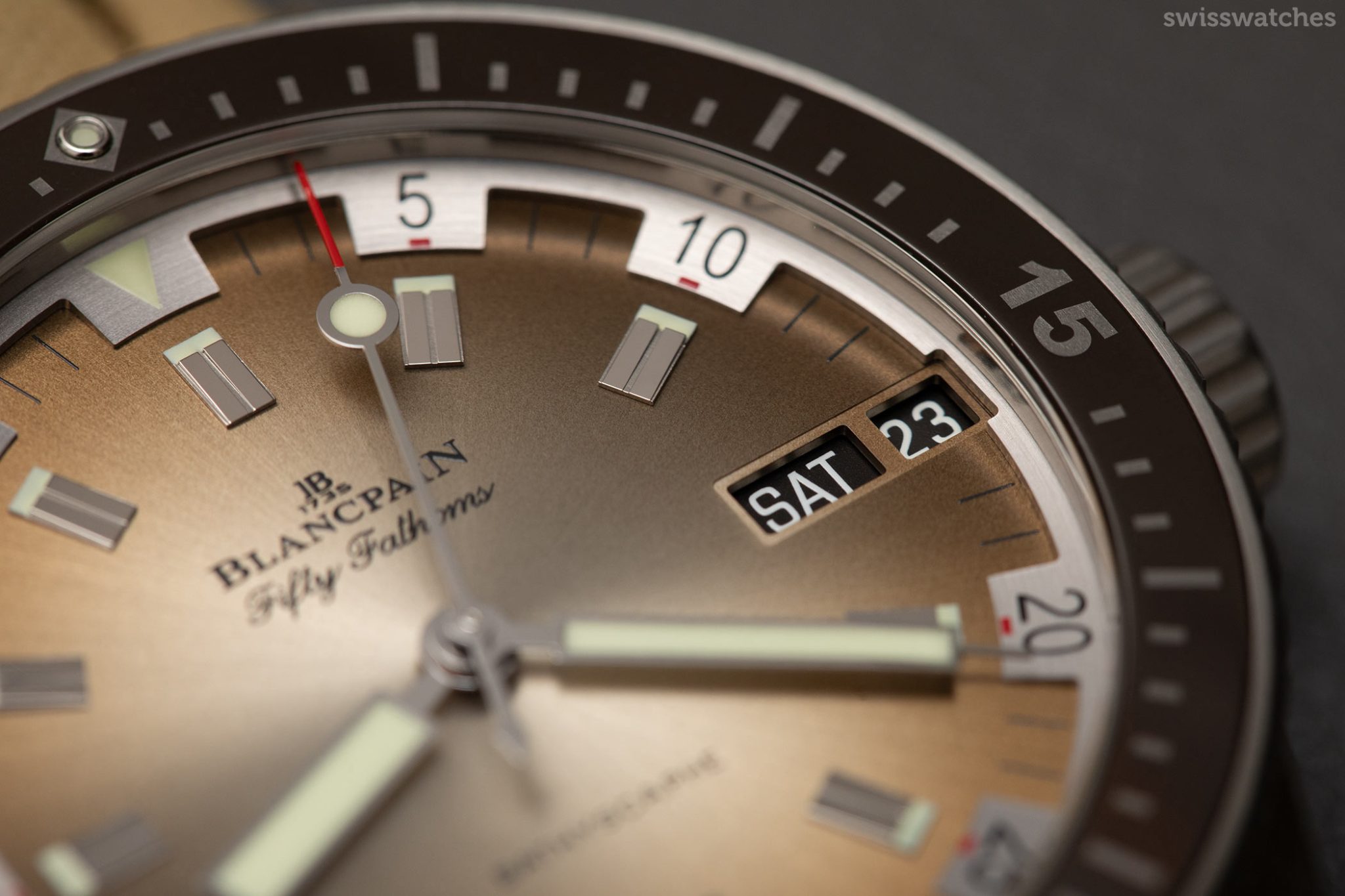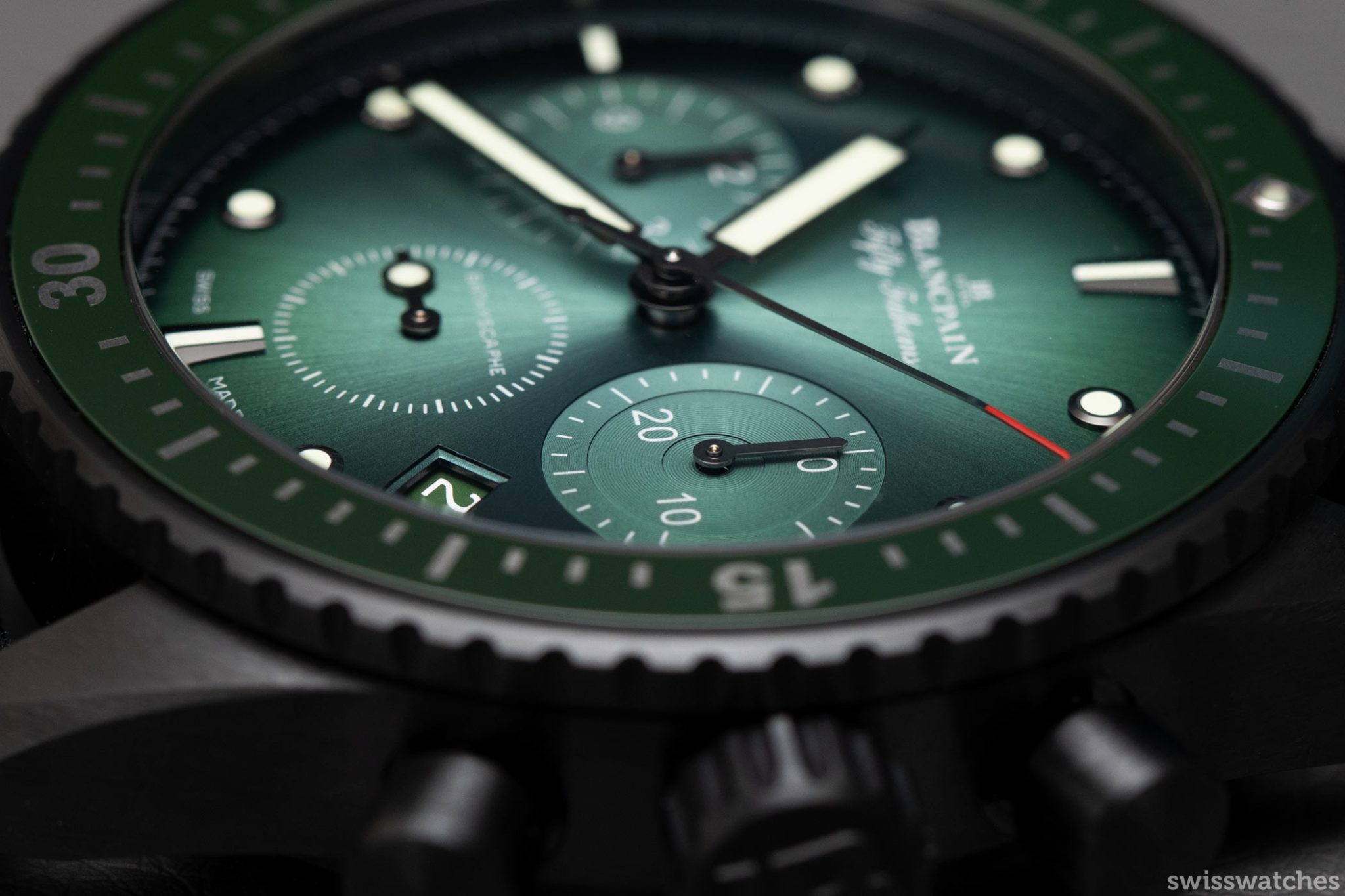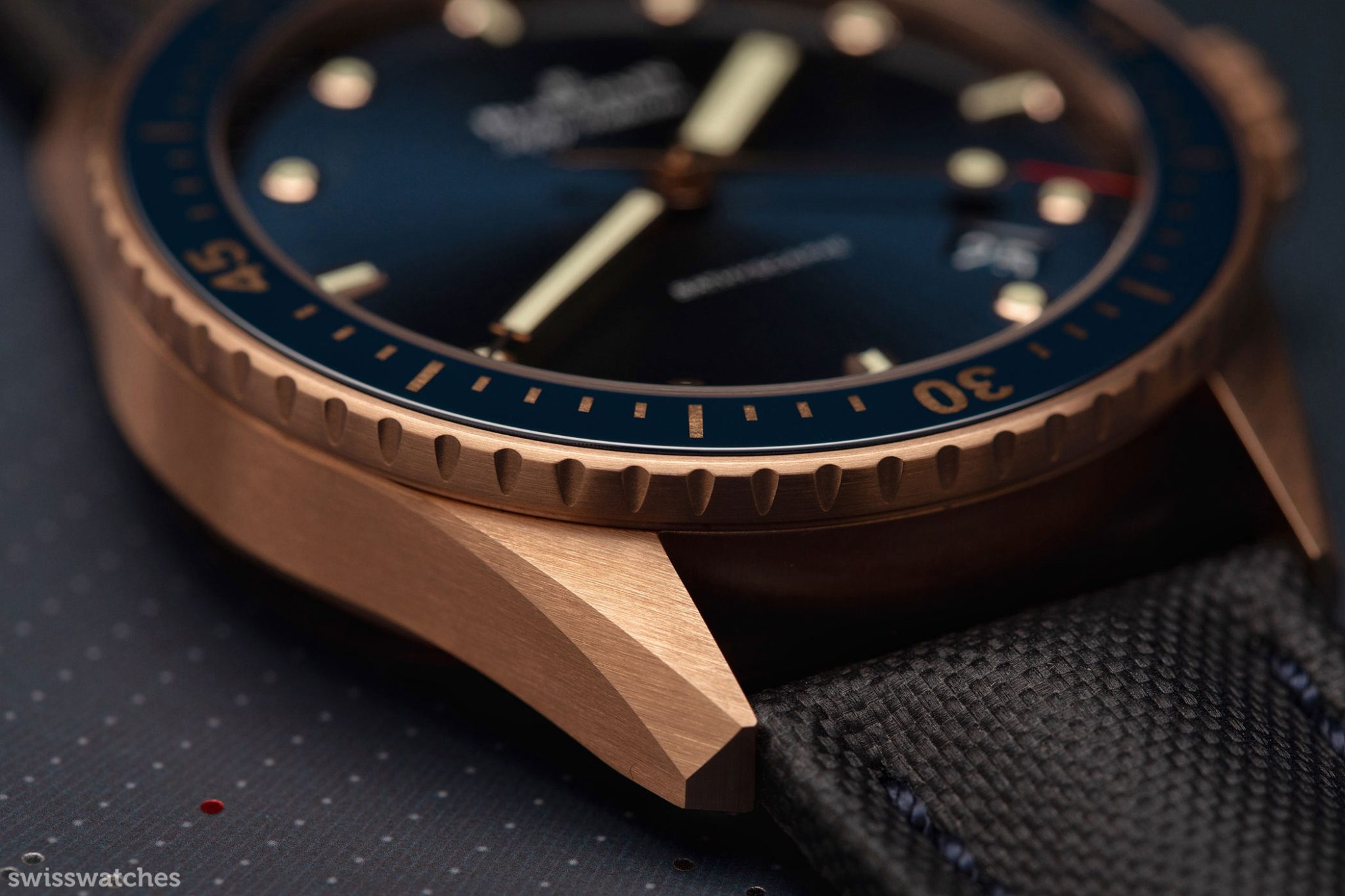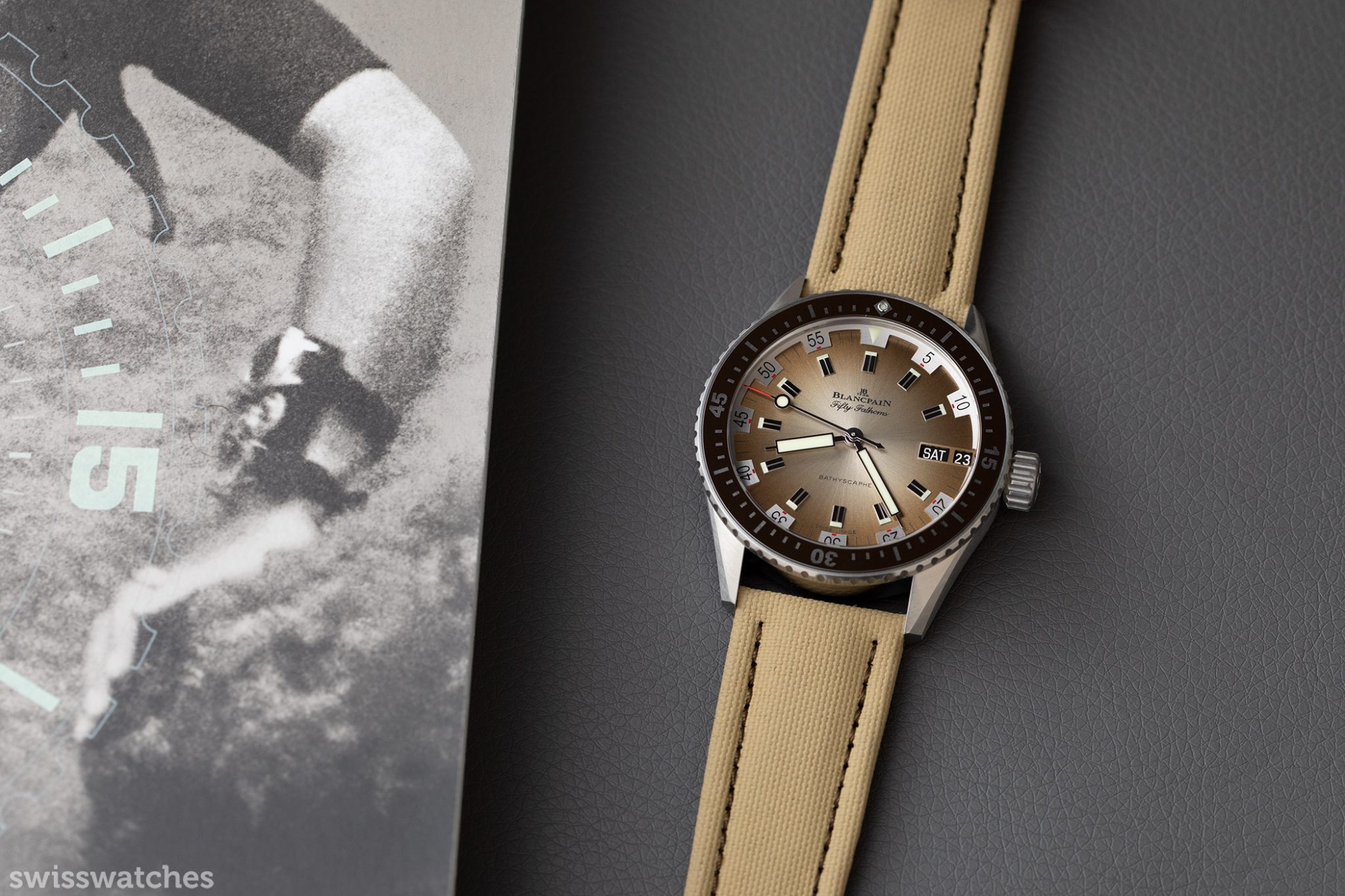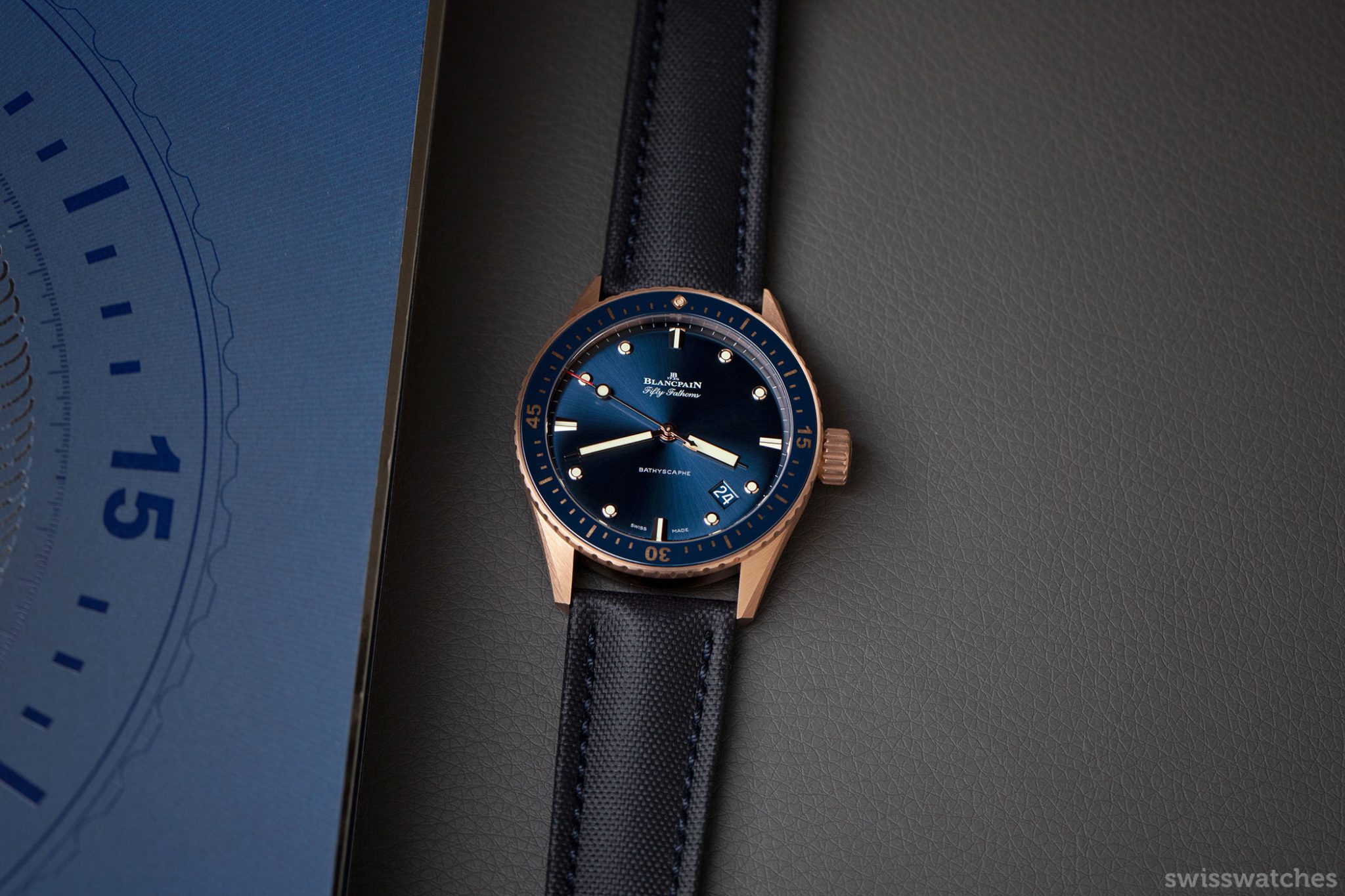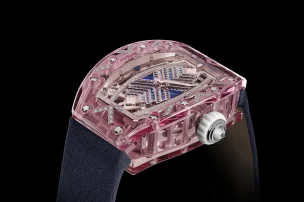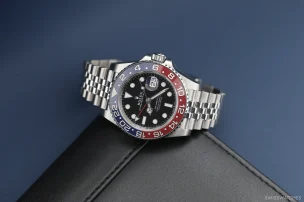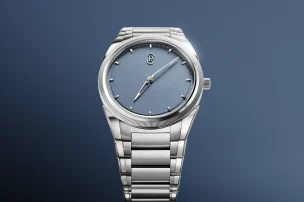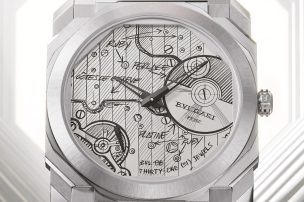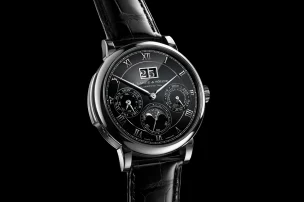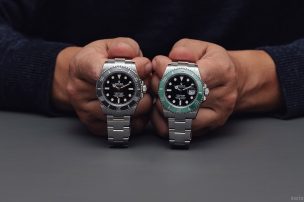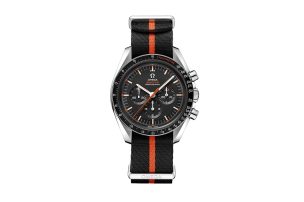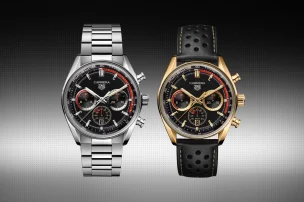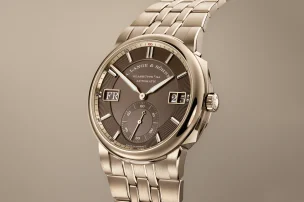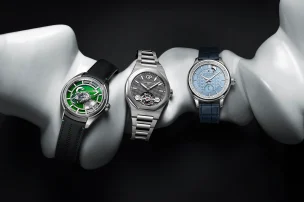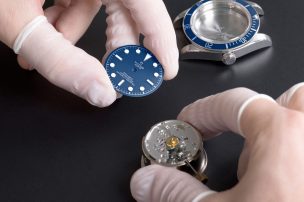
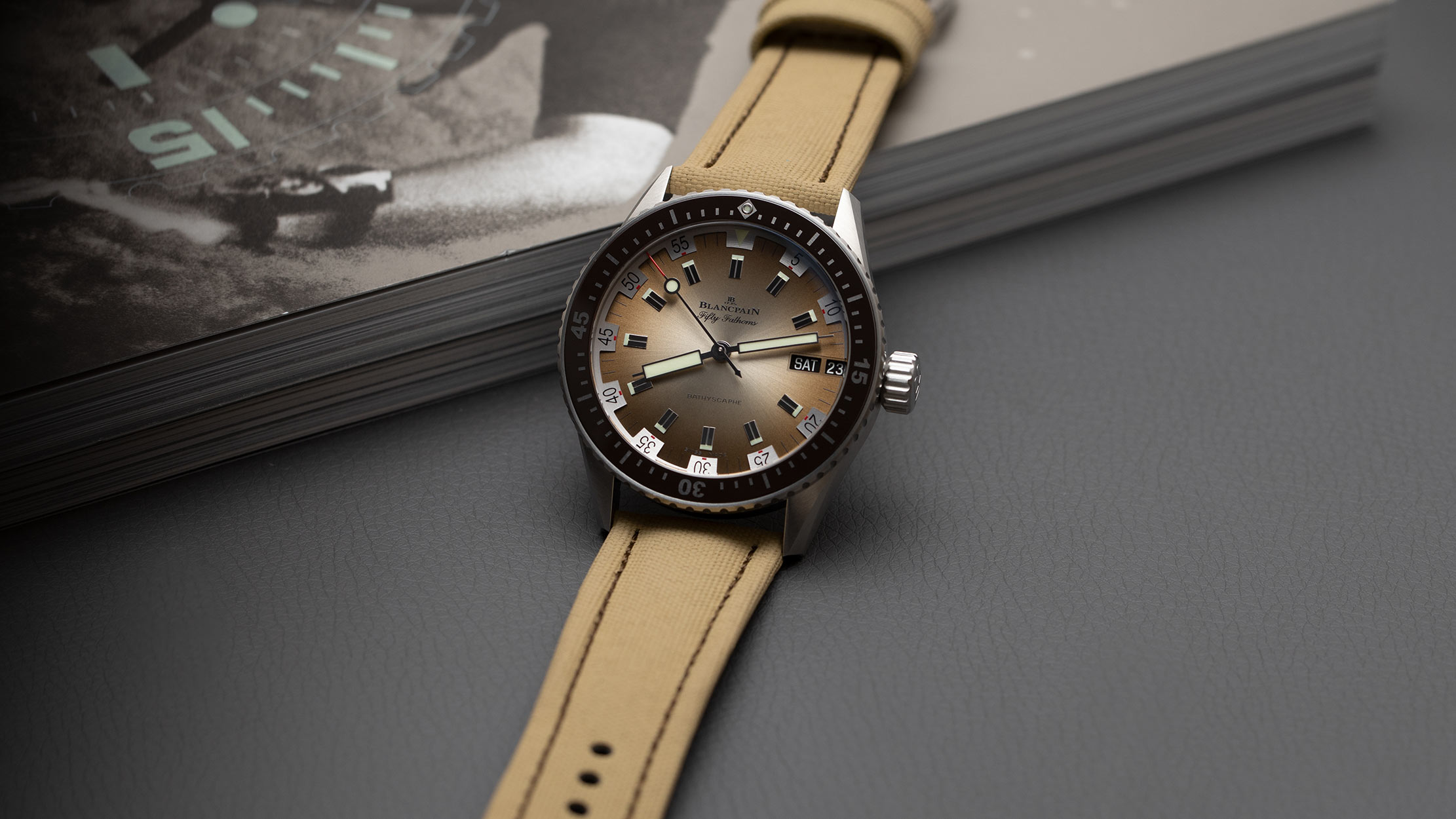
A Closer Look: 2020 Blancpain Fifty Fathoms Bathyscaphe
A near-fatal diving accident is responsible for Swiss watch manufacture Blancpain’s significant contribution to the mechanical diving watch. While other major players such as Rolex, Omega, and Panerai have also earned themselves a certain reputation in this area of expertise, Blancpain can lay claim to having developed decisive features as early as the 1950s with the launch of the Fifty Fathoms model, which improved diving safety from this point onwards. The contemporary Fifty Fathoms collection brings this history to our wrists – with an array of new colour schemes, materials and technologies. We pledged to get to the bottom of the details.
Jean-Jacques Fiechter was a gifted recreational diver. Fiechter was not only general manager of Blancpain from the 1950s until the 80s, but also a member of several diving clubs on the scenic French Riviera. During one of his dives on the Côte d’Azur, despite his expertise, Fiechter suddenly lost track of time – very nearly costing him his life. Diving equipment as we know it today was still in its infancy back in the 50s, meaning divers had to rely on their mechanical timepieces. These primarily served to show the remaining time that the tanks would continue to supply the divers with oxygen.
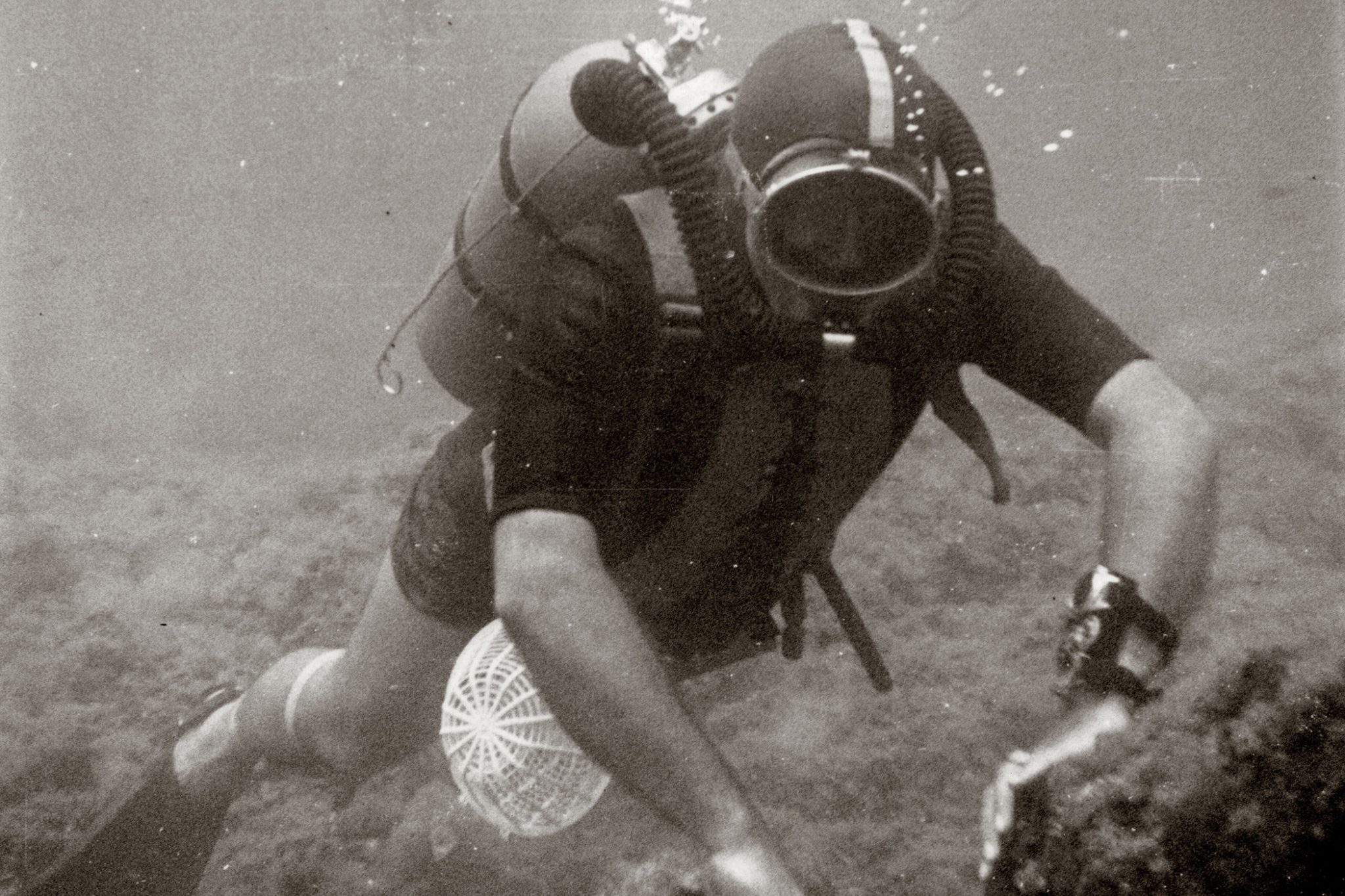
Jean-Jacques Fiechter © Blancpain
In 1953, Blancpain presented its first diving watch, the Fifty Fathoms. Although wristwatches designed for professional divers did exist at the time, they lacked a clear display for calculating oxygen supply – standards in these field were no yet established.
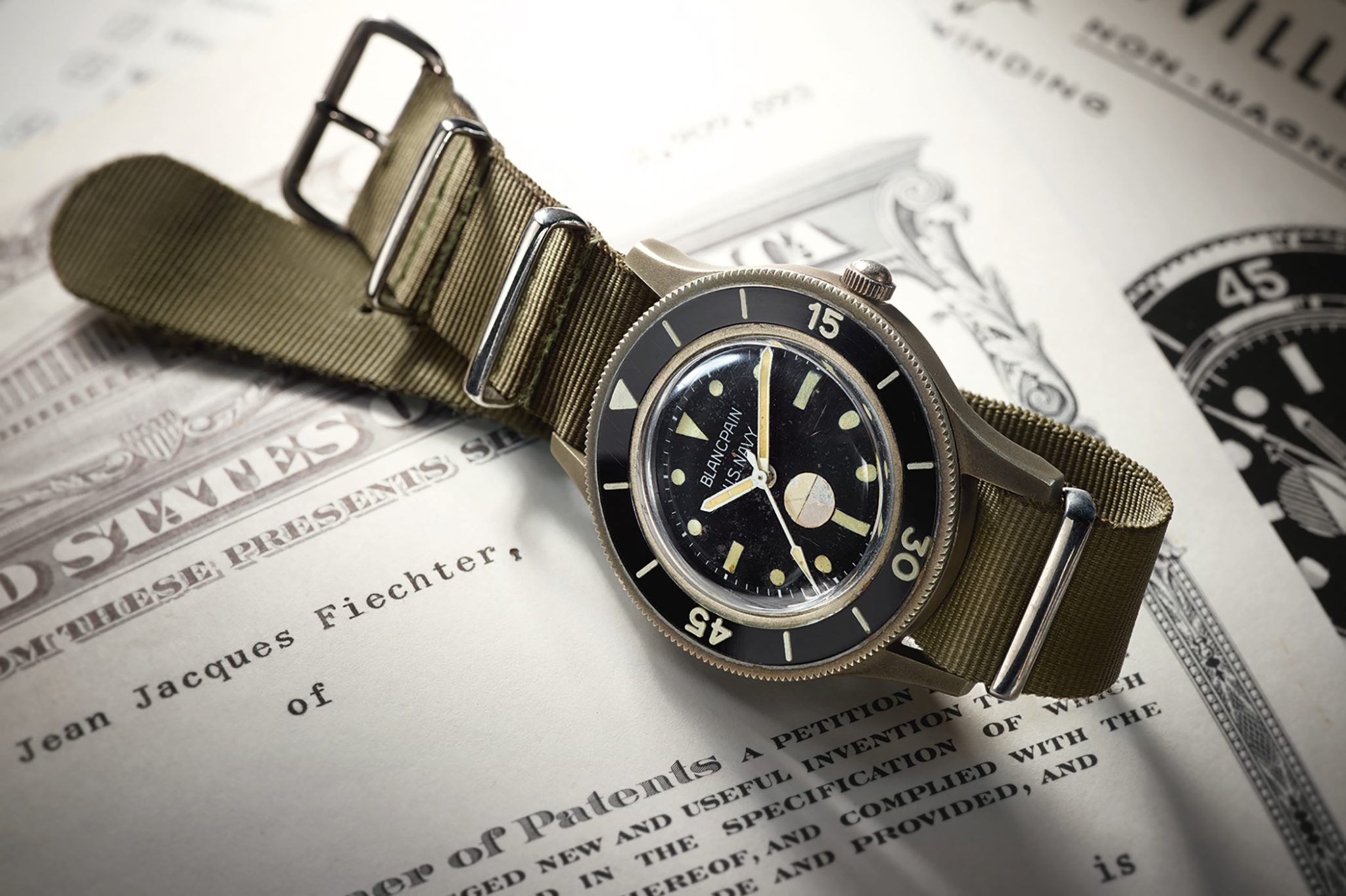
Fifty Fathoms MIL-SPEC II US.NAVY from 1959 © Blancpain
Hence, Fiechter had the simple but genius idea to add a rotating bezel with time scale. But not enough; he developed a very special technique – a patented locking mechanism to prevent inadvertent rotating of the bezel. The original locking system required a push on the bezel in order for it to rotate. This gave divers the security of not accidentally changing the bezel’s setting. It also served to protect the bezel from salt and sand interfering with its operation.
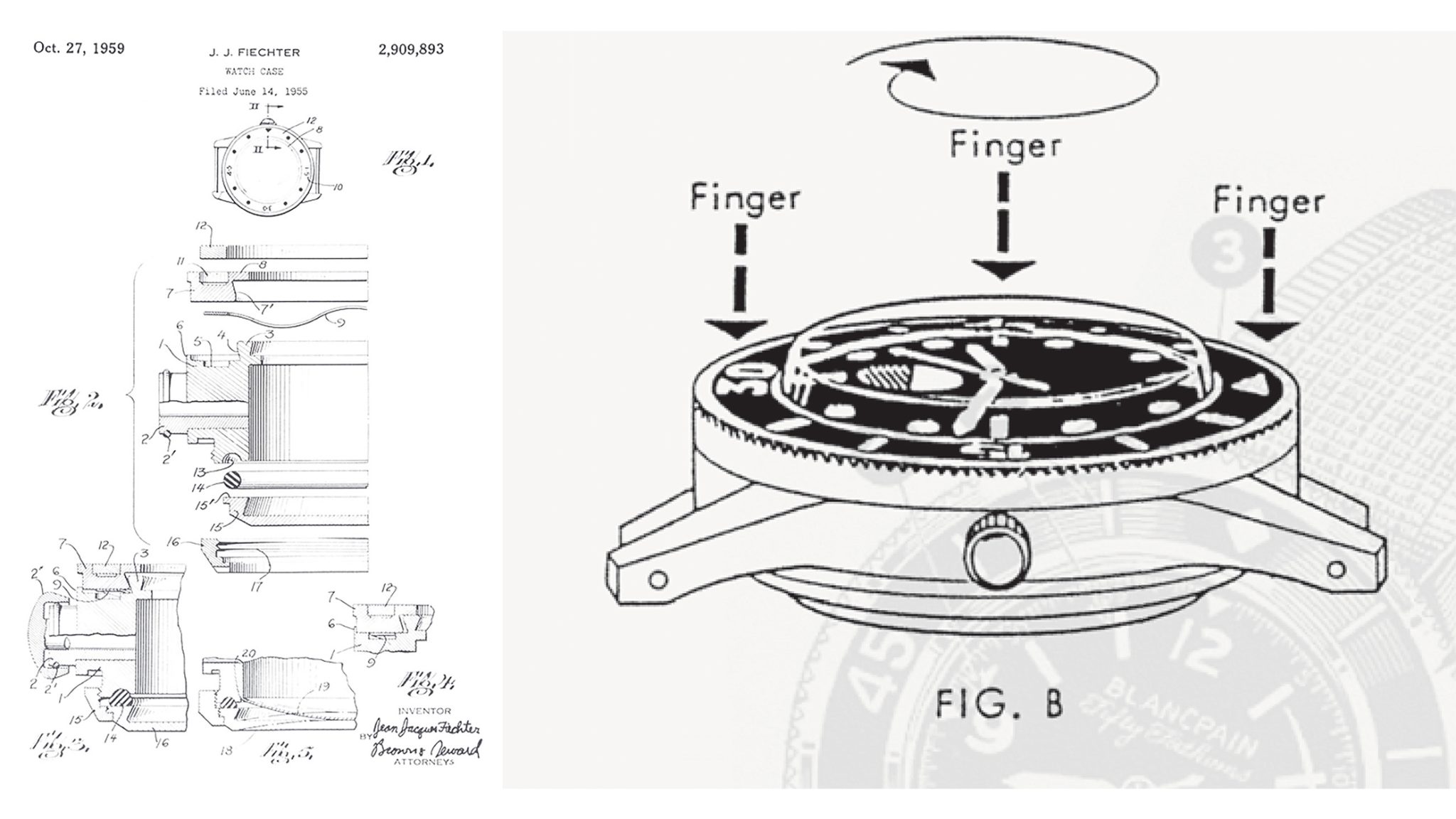
The unidirectional rotating bezel can only be adjusted by pushing it down © Blancpain
The Conception of the Fifty Fathoms
The name Fifty Fathoms referred to the maximum depth that scuba divers at this time could reach – fifty fathoms (91.45 m). In addition to the novel rotating bezel technology, Fiechter conducted research with the help of diving equipment manufacturers to develop effective seals for the caseback and crown, before promptly patenting them. The Fifty Fathoms was also distinguished by its soft inner iron case to protect the movement from magnetism, as well as the highly legible, large white luminous numerals and indexes on a black dial. Blancpain used self-winding calibres to reduce the use of the crown, thus reducing unnecessary changes, as well as preventing entry of water.

The original Fifty Fathoms model from 1953 © Blancpain
Bathyscaphe – a civilian diver’s watch
Blancpain’s Fifty Fathoms models were not only provided to the French combat diving elite “Nageurs de Combat”, following strict selection criteria, but suddenly, diving stores such as the renowned company AquaLung – a specialist in scuba tanks and breathing apparatus, which still exists today – also added Fifty Fathoms watches to their range. This gave Fiechter an idea; the Fifty Fathoms as a civilian diving watch. From then on, he had two target groups in mind: professional divers from the military sector and amateur divers. The Fifty Fathoms, with its case diameter of over 40 mm, was hardly acceptable for everyday use back then. Therefore, in 1956, he designed a watch for a broad target group that could be used both in everyday life and for diving. It was the birth of the Bathyscaphe.

First Bathyscaphe model from 1956 © Blancpain
Its name comes from a special submarine concept “Bathyscaphe” (greek: bathys = deep und skaphos = vessel) developed by the Swiss researcher Auguste Piccard, for his deep-sea dives. Piccard’s Bathyscaphe vessels were somewhat of a cross between a diving bell and submarine that was self-propelled.
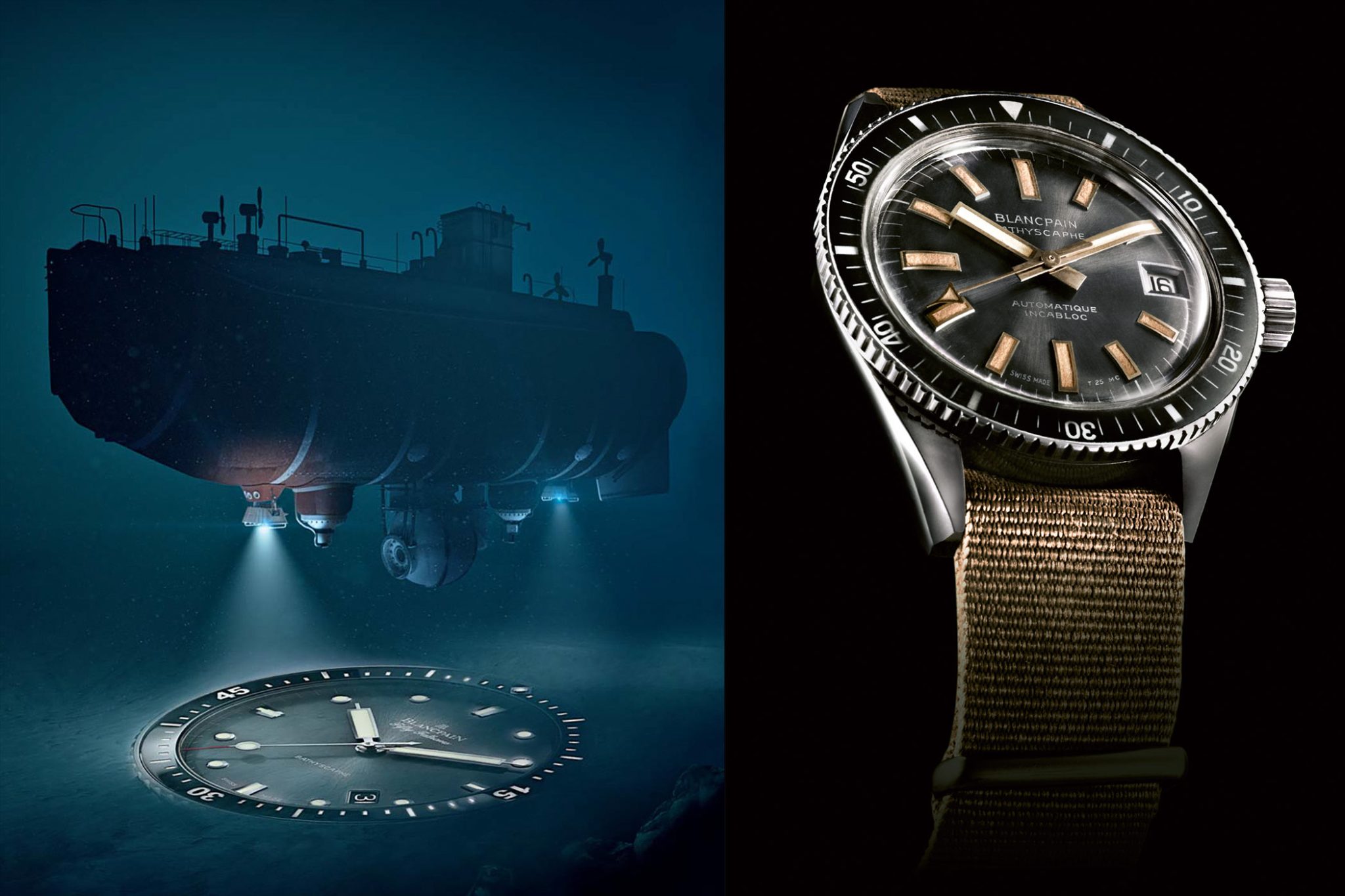
Its name comes from a special submarine concept “Bathyscaphe” © Blancpain
The new Bathyscaphe watches from Blancpain had a smaller case diameter of 37 mm. Later, a date and day of the week display were added; useful functions for everyday life, which of course also boosted sales. The Bathyscpahe Day Date from the 1970s transformed the tool watch into a sporty fashion accessory. It suddenly got a cushion-shaped case, simply because it was en vogue at the time. The rotating bezel, once the hallmark of Blancpain’s diving watches, was replaced by an inner rotating ring on the dial – a subtle adjustment in favour of trend developments, without throwing the design code overboard, literally.
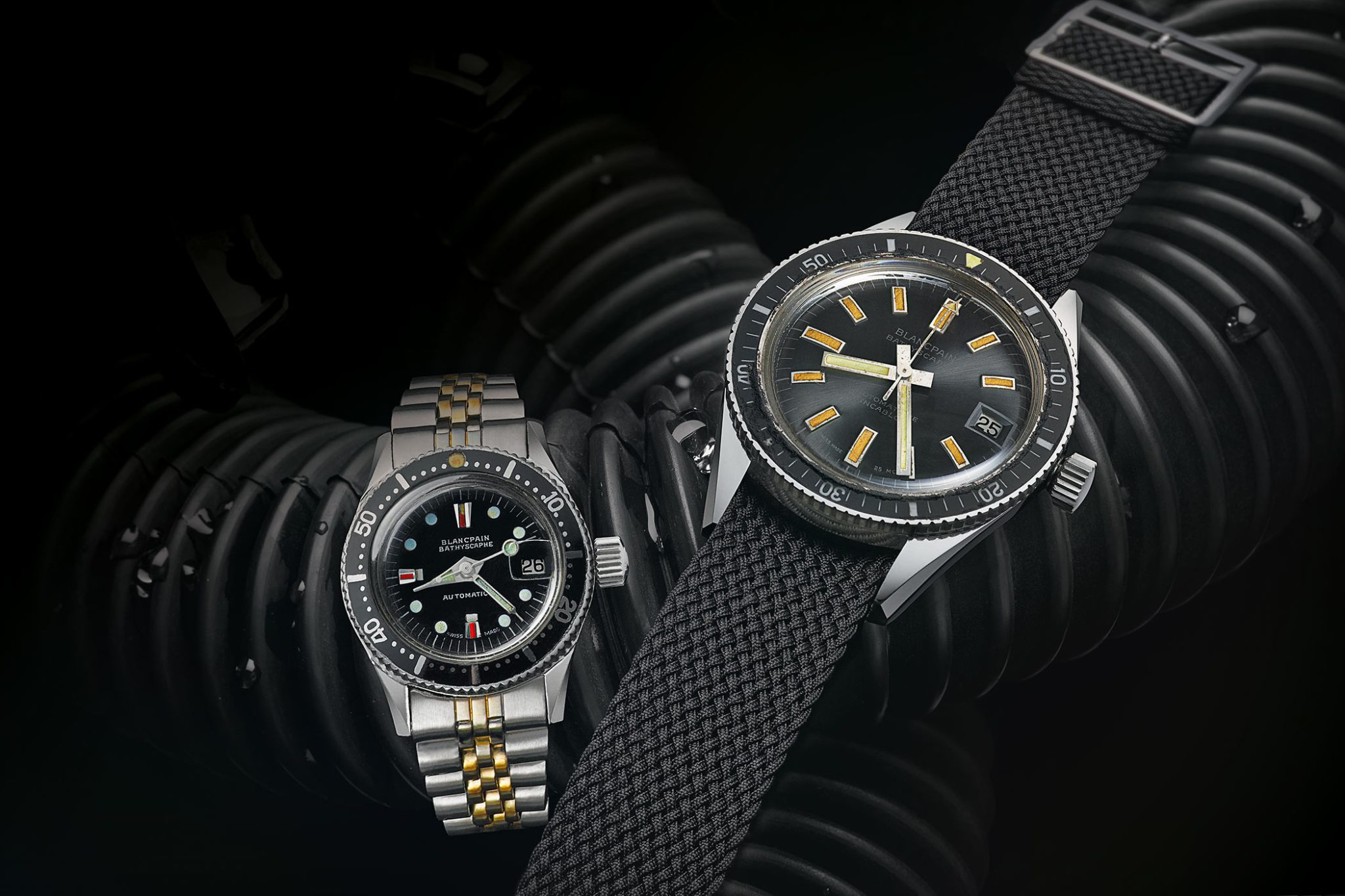
The Bathyscaphe next enjoyed a revival in 2013 on the occasion of the 60th anniversary of the Fifty Fathoms. Since then, it has been in high demand and updated with new executions every year. At Baselworld 2018, Blancpain presented three new Bathyscaphe models. This year, Blancpain is adding three more models to the line.
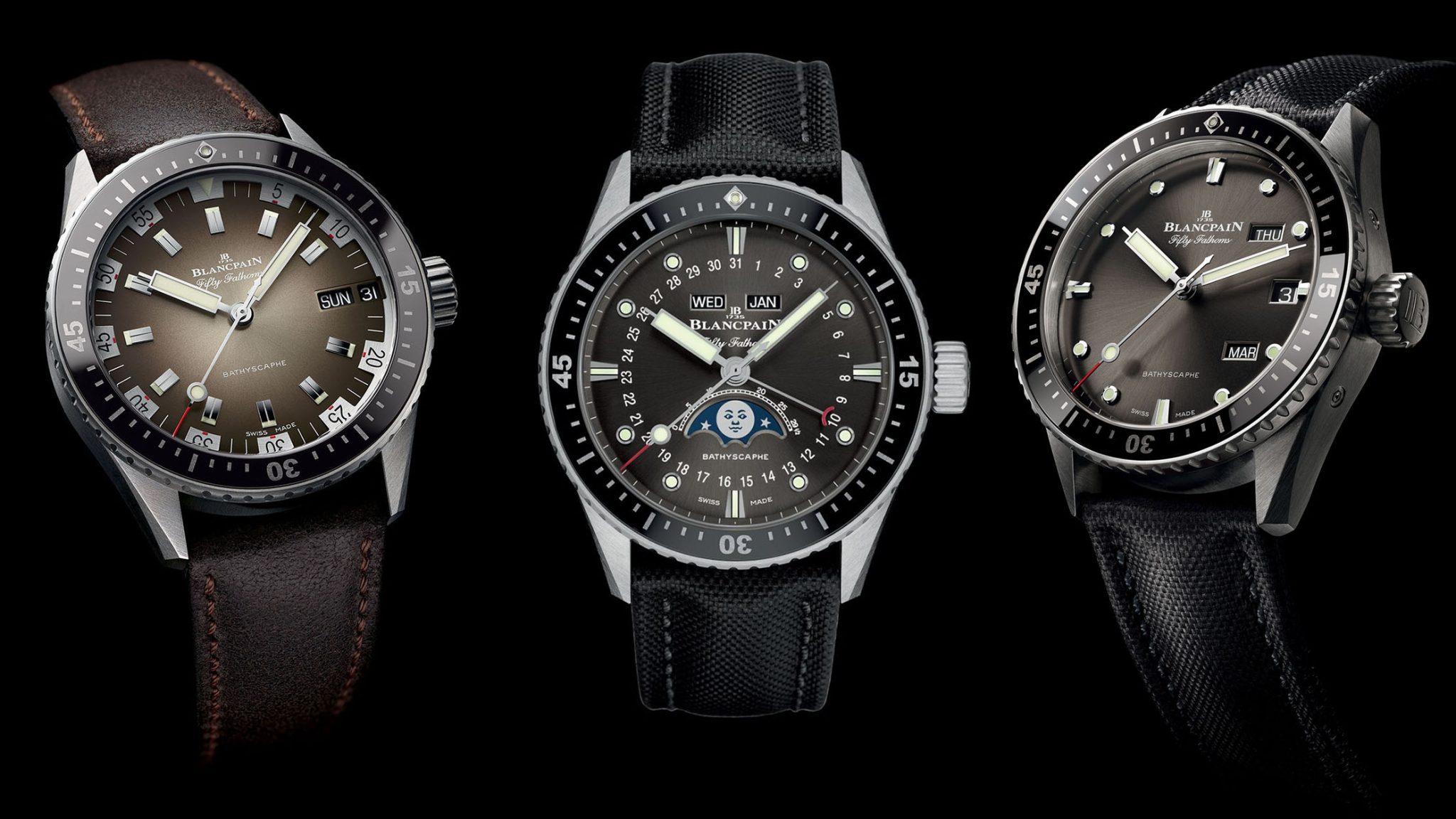
The Fifty Fathoms Bathyscaphe novelties from Baselworld 2018
Blancpain Fifty Fathoms Bathyscaphe Day Date Desert Edition
The Bathyscaphe Day Date models are inspired by Blancpain’s later diving watches, which were launched in the 1970s. When comparing the original with the re-edition, it is striking to see that the oval case shape has not been adopted in the modern watches. The inner rotating bezel has also disappeared, and the outer rotating bezel has returned. Even though Blancpain speaks of having created new editions that are true to the original, these are definitely two different watches. It’s obvious that a diver’s watch is always associated with a rotating bezel, although I really like the vintage case design of the originals – and would actually also enjoy seeing them in the modern versions.
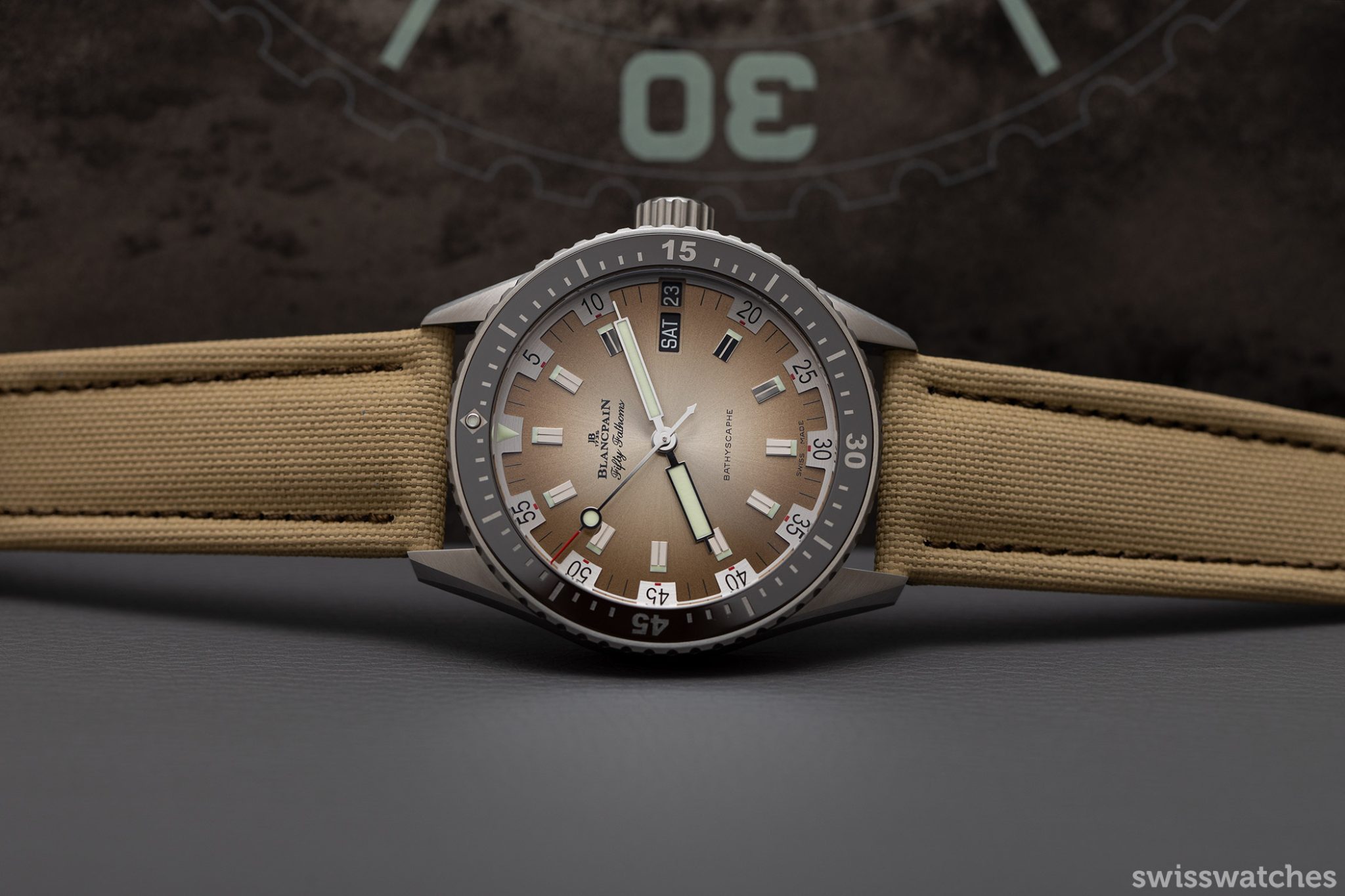
Blancpain Fifty Fathoms Bathyscaphe Day Date Desert Edition
Instead, today, a minute circle with Arabic numerals in 5-minute intervals is reminiscent of the inner rotating bezel of the original models from the 1970s. The unidirectional rotating bezel has been adopted from the original Fifty Fathoms watches. While the diving scales of the Fifty Fathoms are protected by a sapphire crystal inlay, the Bathyscaphe models feature ceramic inlays. In the past, aluminium was commonly used, but this did not prove to be particularly robust. Sapphire crystal and ceramic are scratch-resistant – ceramic is, however, somewhat more high-quality, and therefore better fits the more noble Bathyscaphe models. The rectangular hour markers and chunky baton hands with Super-LumiNova® resemble the original Bathyscaphe divers of the 1950s.
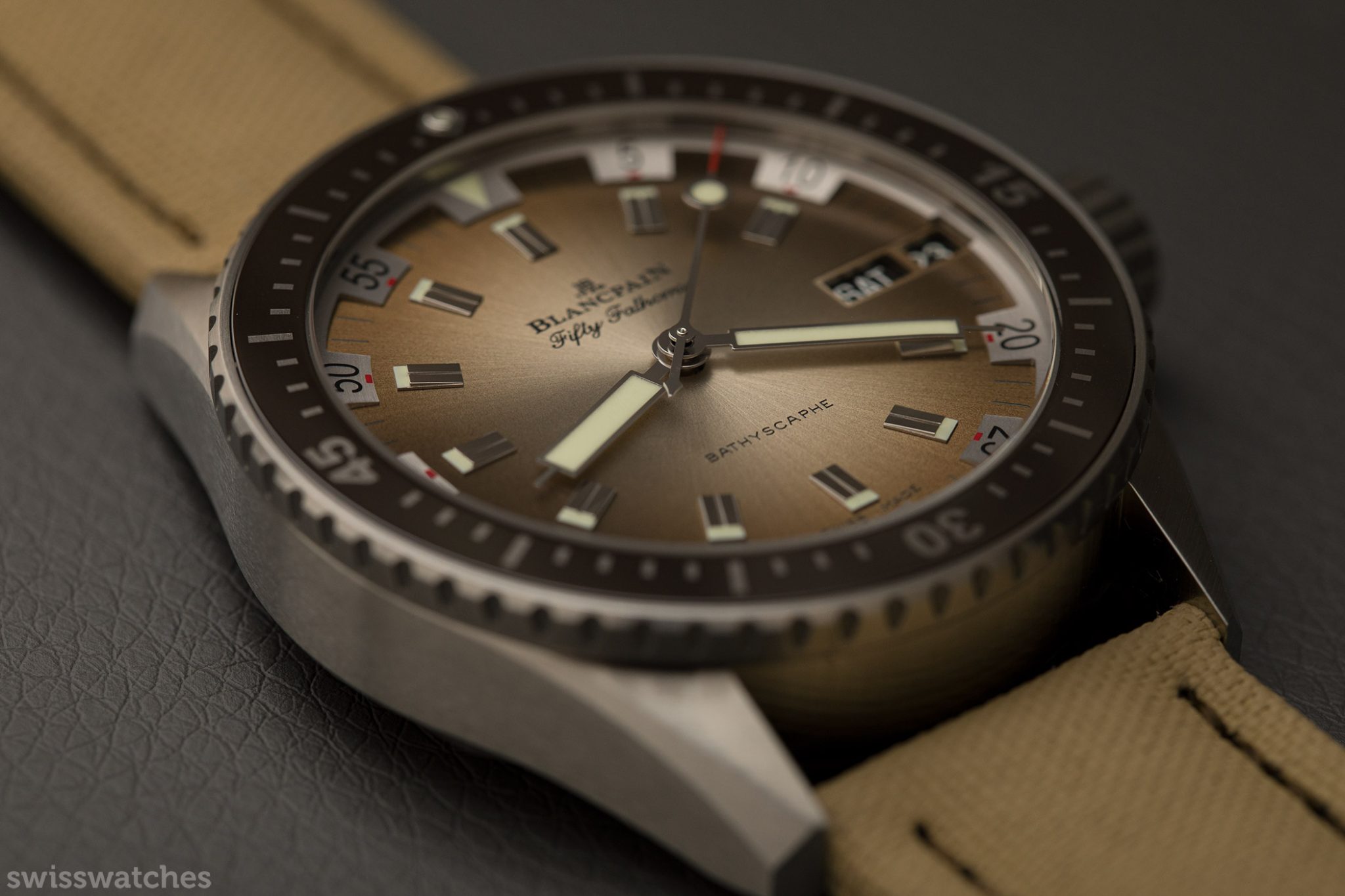
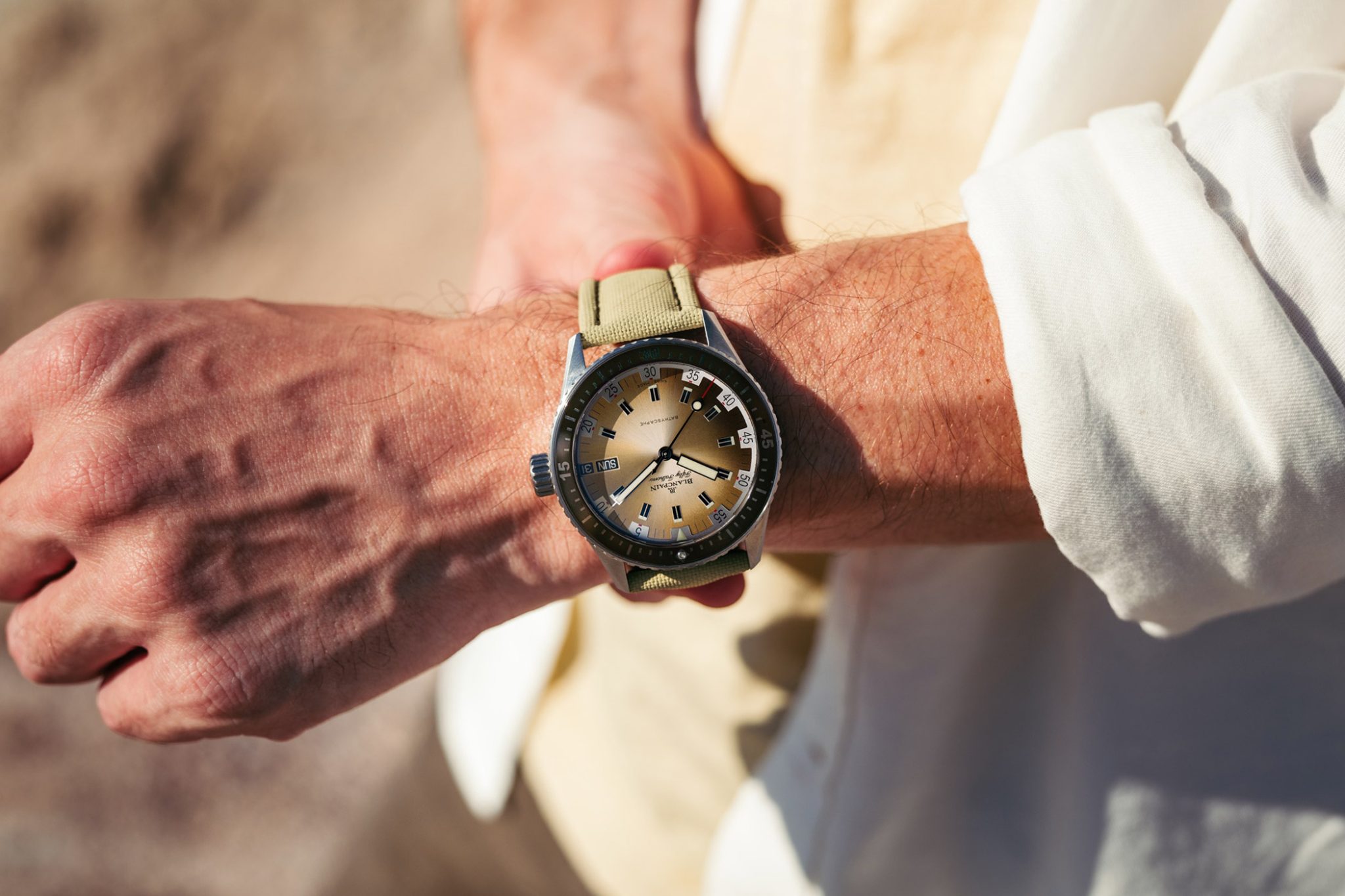
In 2018, Blancpain launched a modern Day Date version for the first time, the Bathyscaphe Day Date 70s Limited Edition, with a grey-brown dial, limited to 500 pieces. This year, the Day Date is making another appearance, this time with a sand-coloured dial. The watchmakers were inspired by the Death Valley Desert in California, where Ernest H. Brooks made a 120-metre dive into Devils Hole in 1962. The pioneer and underwater photographer took part in several Blancpain projects. This explains the connection to the new Desert Edition.
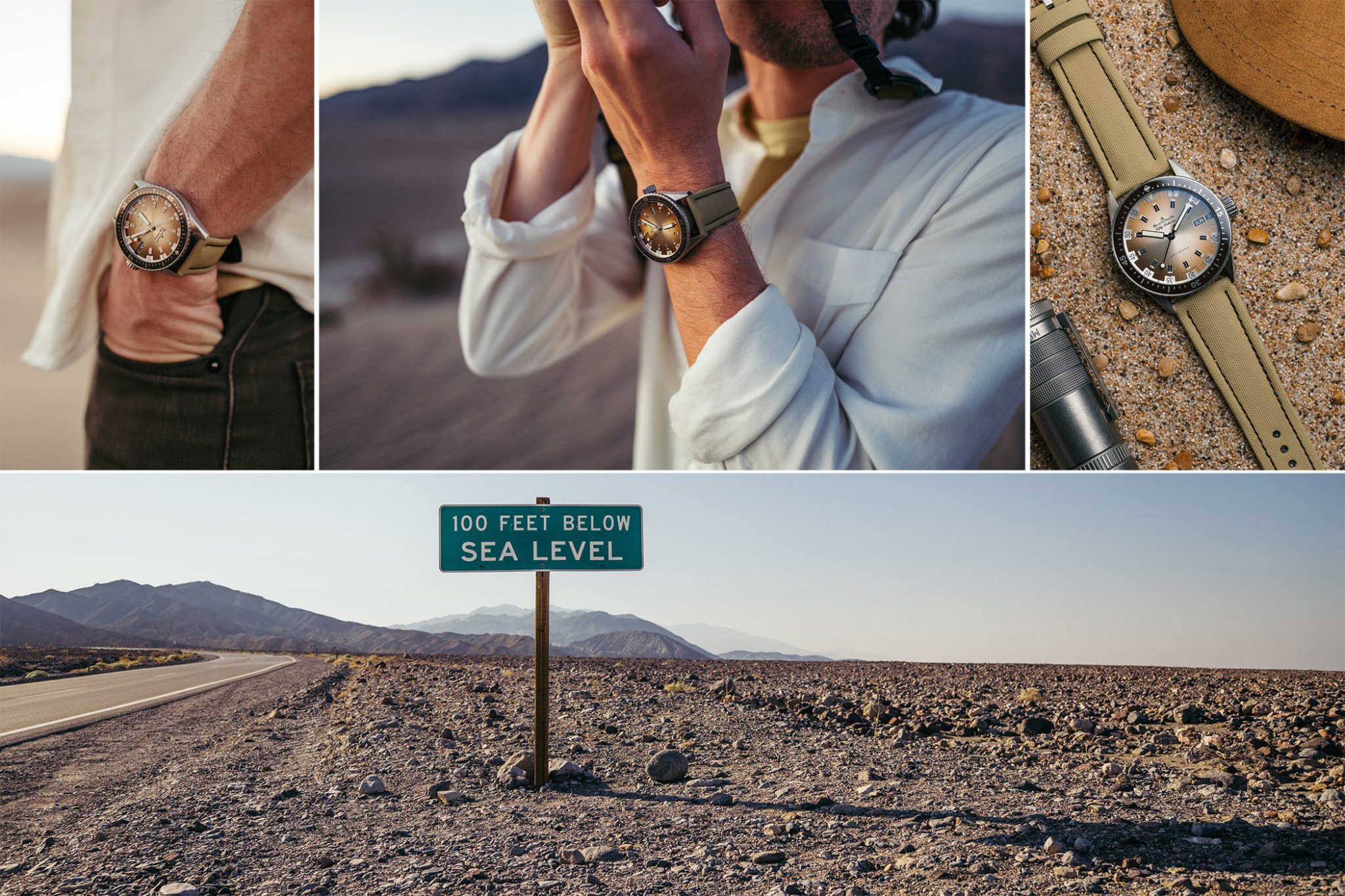
Blancpain is, of course, not primarily known for its toolwatches, but for its Haute Horlogerie expertise, and elaborately decorated dials. With this watch, a robust water-sports wristwatch meets fine watchmaking. As early as the 1970s, the dials of the Bathyscaphe shimmered with impressive sunburst patterns, radiating from the centre in iridescent lines. The dial goes through a two-step polishing process to remove scratches, giving the surface a soft, smooth finish. In the new Fifty Fathoms Bathyscaphe Day Date Desert Edition, the sand-coloured graduated dial features sunburst decoration. The typical date and weekday are placed at 3 o’clock. The 43 mm case (Fifty Fathoms usually measure 45 mm) is made of satin-finished steel and is water-resistant to 300 m.
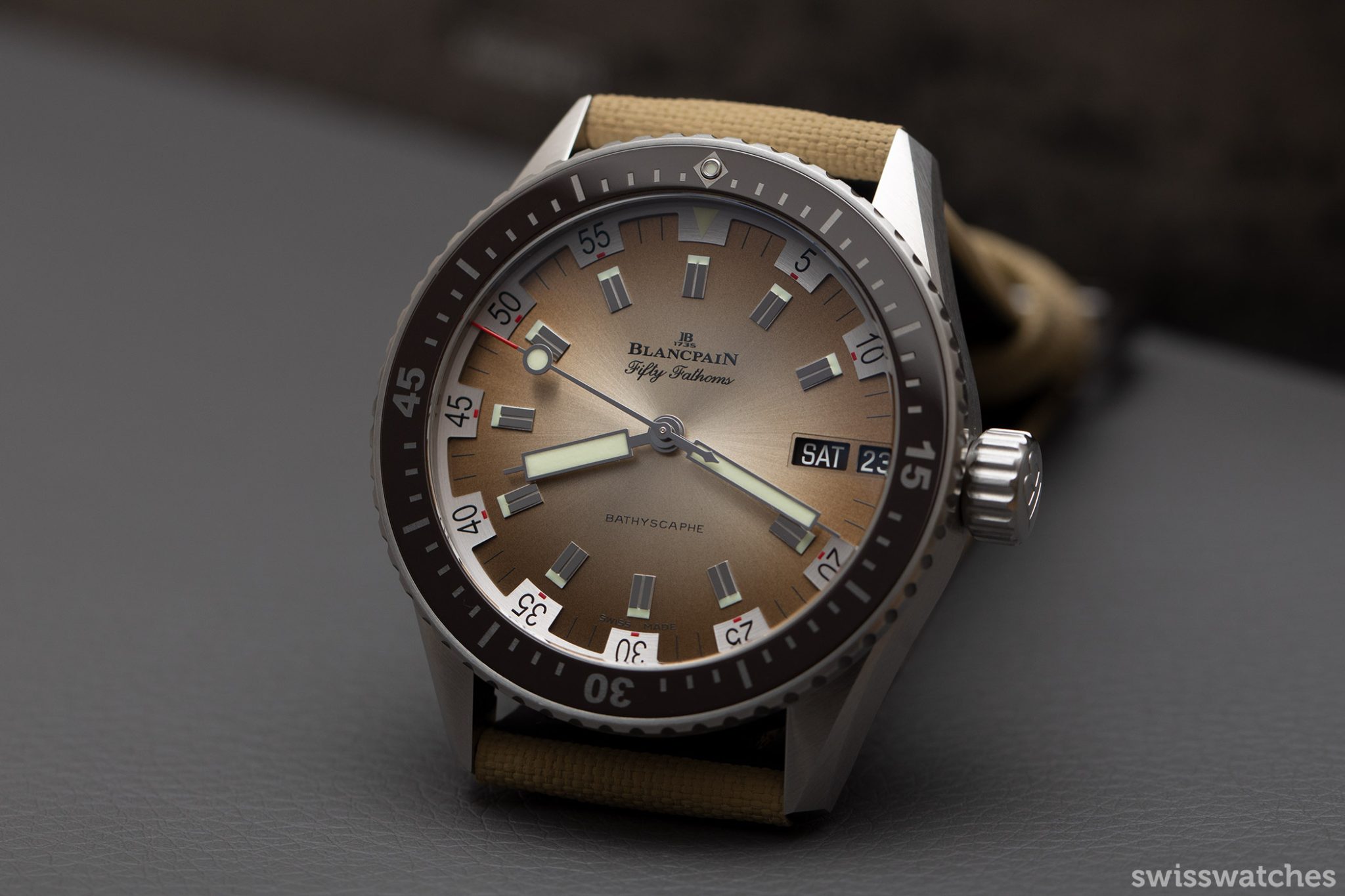
The watch is equipped with a 1315DD movement with a five-day power reserve and a silicon balance spring. It is therefore anti-magnetic; a feature that was already essential for a true diving watch in the early days. In those days, movements with a soft iron casing inside the case were shielded from the influence of magnetic fields. The traditional balance spring made of a metal alloy was extremely fragile. Blancpain was one of the pioneers in the introduction of anti-magnetic silicon hairsprings, thanks to the expertise of its parent company, the Swatch Group. Another advantage: a transparent sapphire crystal caseback now allows for a view of the movement.
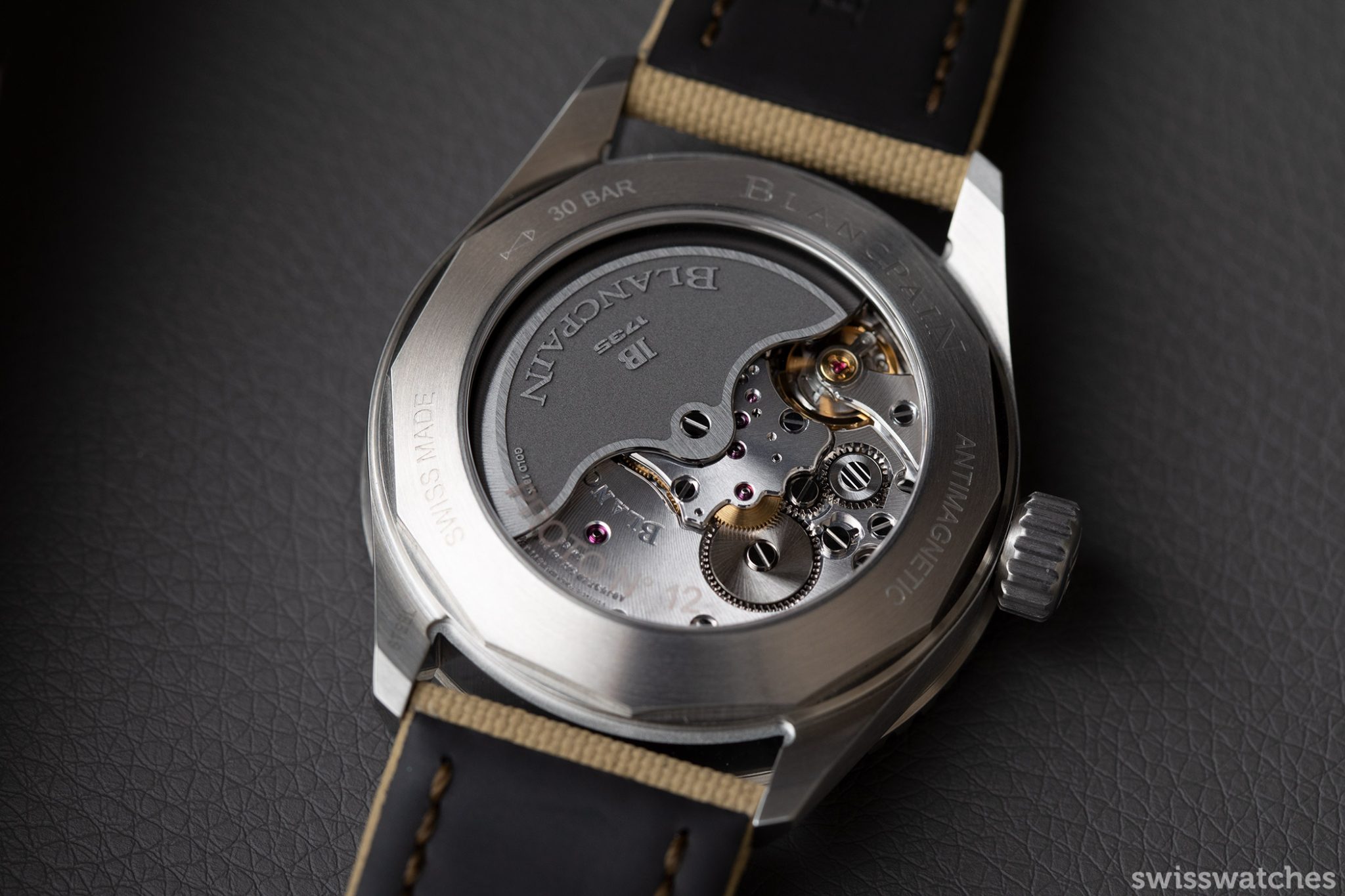
Movement 1315DD with a five-day power reserve and a silicon balance spring
In this model, the first thing that catches the eye is the rotor made of 18k gold, which is coated with a special platinum-based alloy (NAC). The Fifty Fathoms Bathyscaphe Day Date Desert Edition is worn on a sand-coloured canvas strap. Price: 11,780 euros.
Blancpain Fifty Fathoms Bathyscaphe Chronographe Flyback
One year after the reintroduction of its Bathyscaphe line, a Flyback Chronograph was also added. The model is available in black, blue and even meteor grey – and as of more recently, in green. However, not only the dial shimmers green, but also the rotating bezel with a green ceramic insert. The hour markers are made of Liquidmetal®, which some people may know from their OMEGA, first introduced in 2009.
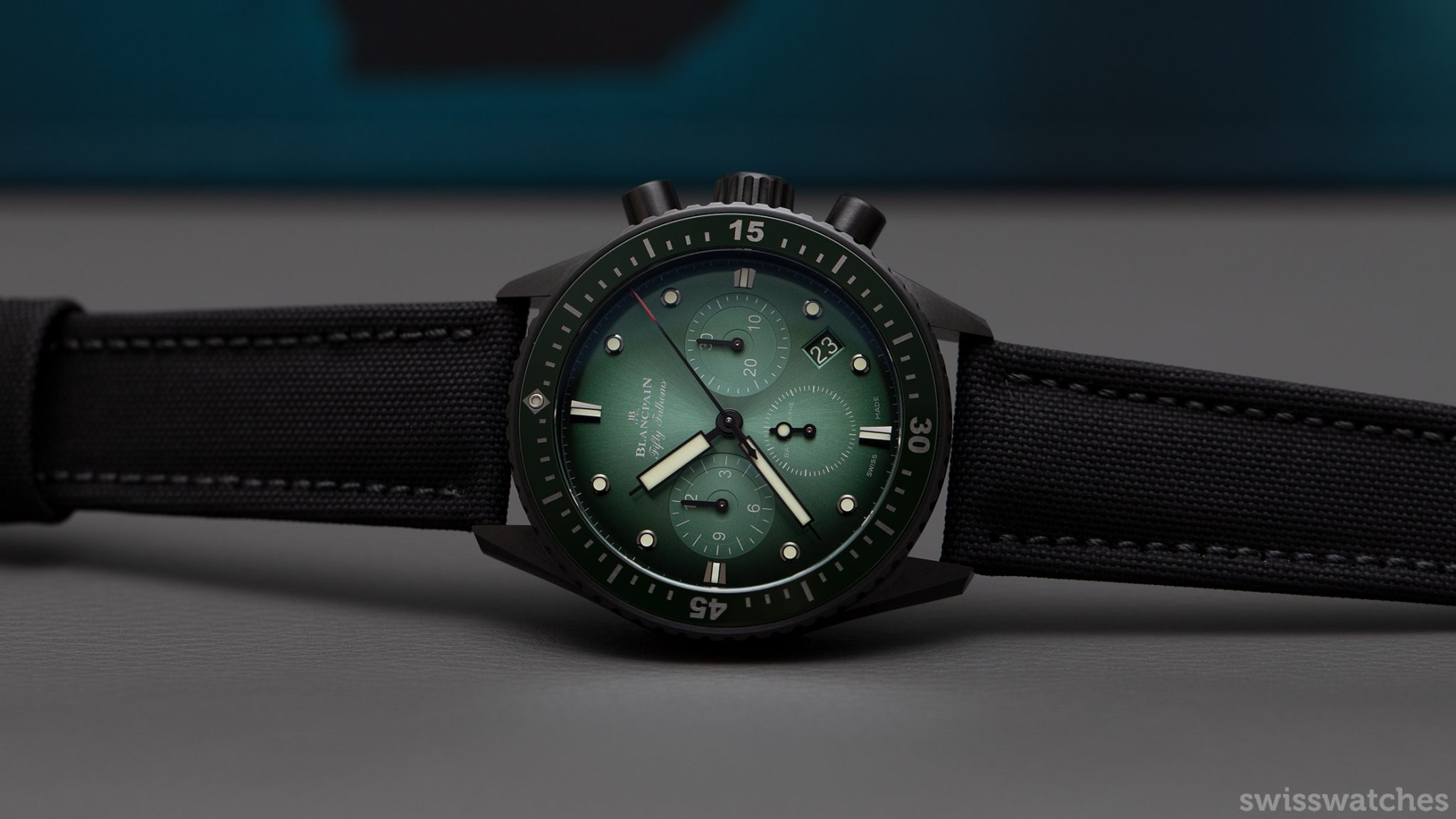
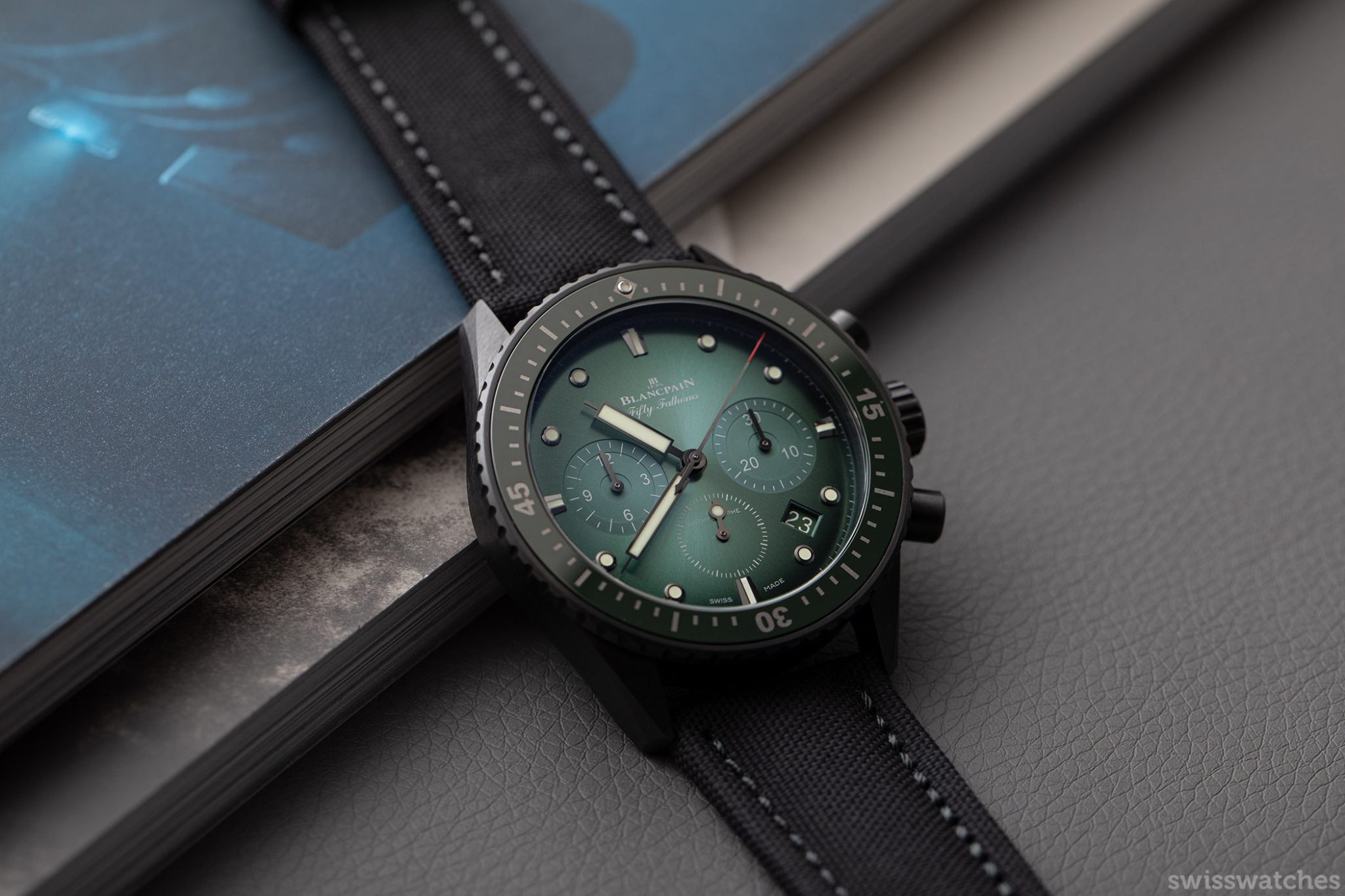
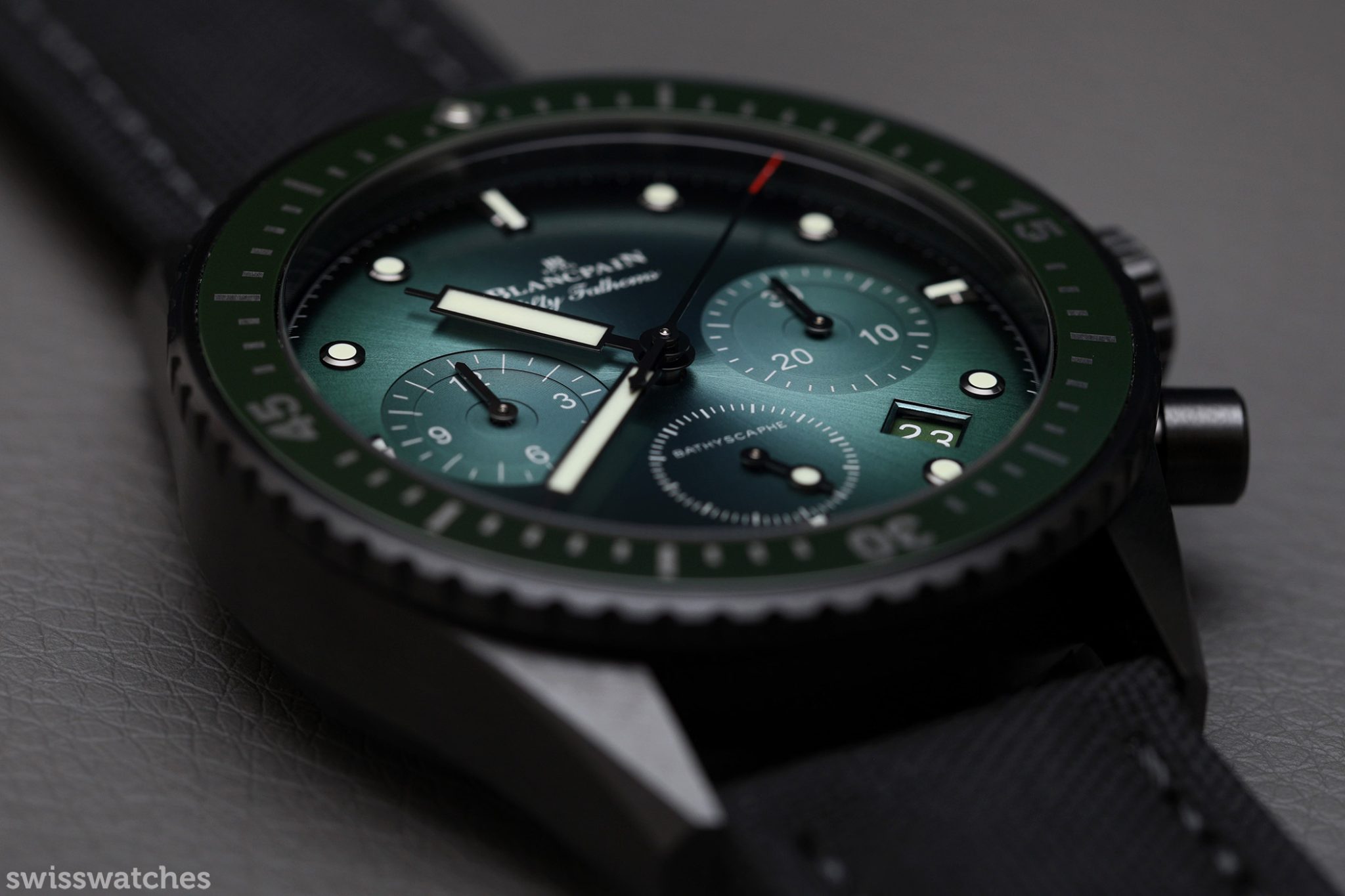
Blancpain Fifty Fathoms Bathyscaphe Chronographe Flyback
Anyone who has the opportunity should see the impressive shimmering of the light reflections on the dial for themselves. When the dial is coloured, several nanometric fine layers of material are deposited. The light rays then reflect the desired colour tone and gleam with metallic nuances, changing with the angle of the dial. The chronograph counters are deepened and azuré, which makes the dial even more interesting in combination with the sunburst decoration. And it’s also a good design technique, because it gives the many light reflections of the main dial some harmony and sense of calm. A particularly nice detail is the small second hand on the lower subdial counter, which has a lollipop-like hand that uses strong luminous material.

© Picture (right) by Harald-Hois
With an overall height of 15.25 mm, you should be aware that this watch is not for the typical shirt-wearing guy. Even if the Bathyscaphe wants to be fashionable, it is still a diver’s watch – and in this case a chronograph, which according to the manufacturer can even be used at a depth of up to 30 bar. It is powered by the automatic manufacture calibre F385, which was designed for this model back in 2014; a 5 Hz, high-speed oscillator with vertical clutch and chronograph mechanism, controlled by a column wheel. The movement can be admired through the open sapphire crystal caseback of the 43.6 mm case, made of satin-finished black ceramic.

Automatic manufacture calibre F385
The Fifty Fathoms Bathyscaphe Chronographe Flyback is worn on a NATO or canvas strap. A final nice detail is that the buckle and loops are also ceramic, and have been carefully finished. Price: 15,840 euros.
Blancpain Fifty Fathoms Bathyscaphe Sedna® Gold
The third novelty introduced by Blancpain this year is a Bathyscaphe with a 43 mm Sedna® Gold case with a blue dial and bezel. This material is also used within the Swatch Group, by OMEGA. Sedna® Gold is an alloy of gold, copper and palladium, giving it a unique rose-gold tone. The unidirectional rotating bezel is also made of Sedna® Gold, with a ceramic insert plus a time scale and indices in Ceragold®.
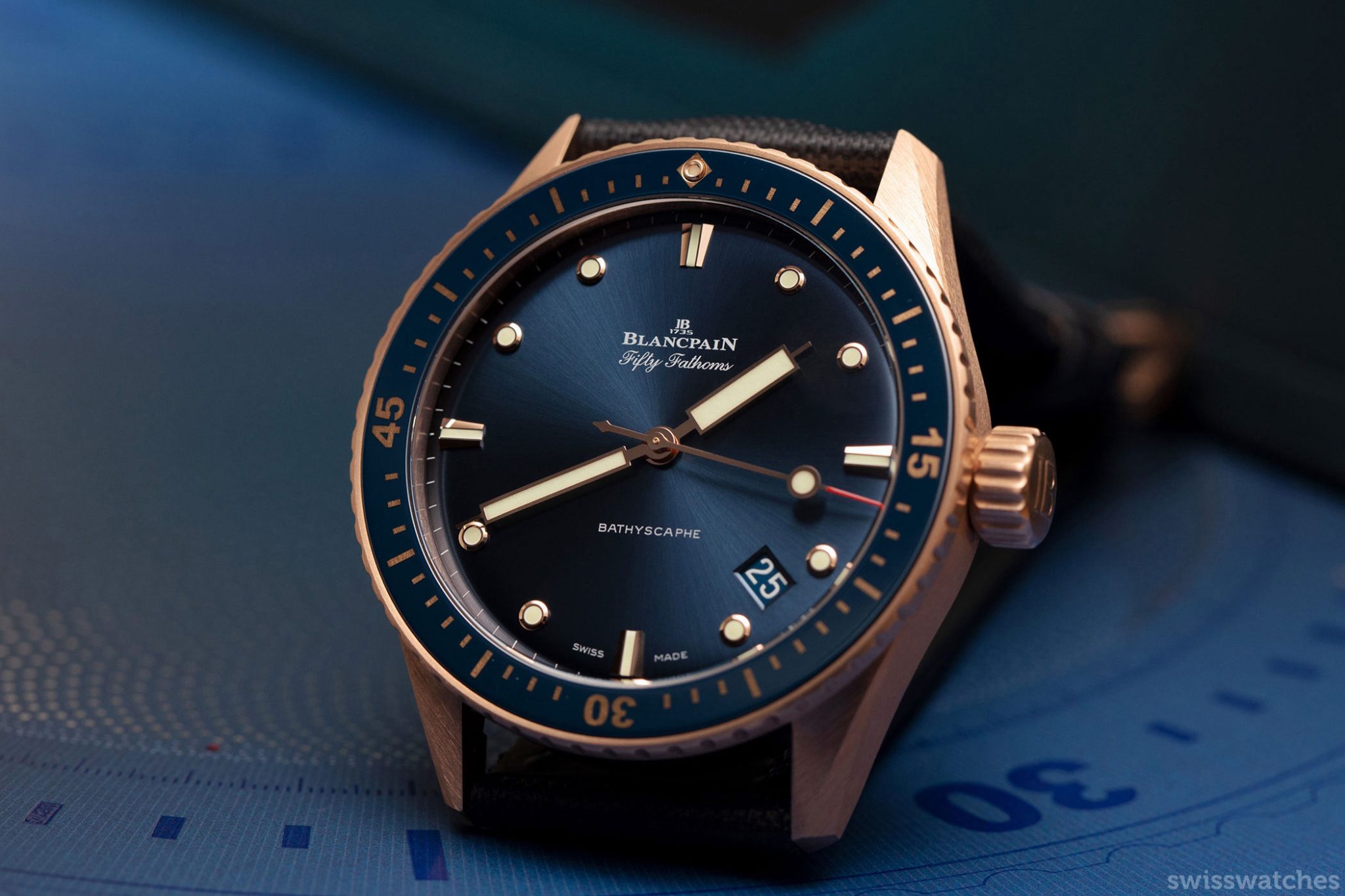
Blancpain Fifty Fathoms Bathyscaphe Sedna® Gold
Unlike the Day Date models, the design here is based on the first Bathyscaphe watches of the 1950s. They had the typical luminescent rectangular hour and minute hands, as well as rectangular hour-markers – in this case, complemented by fine gold dots and covered with Super-LumiNova® coating. What was not so important for the divers back then is useful in everyday life today, so they also have a slim second hand and a date display, which I personally would like to see back at 3 o’clock, just like in the first Bathyscaphe models from 1956.
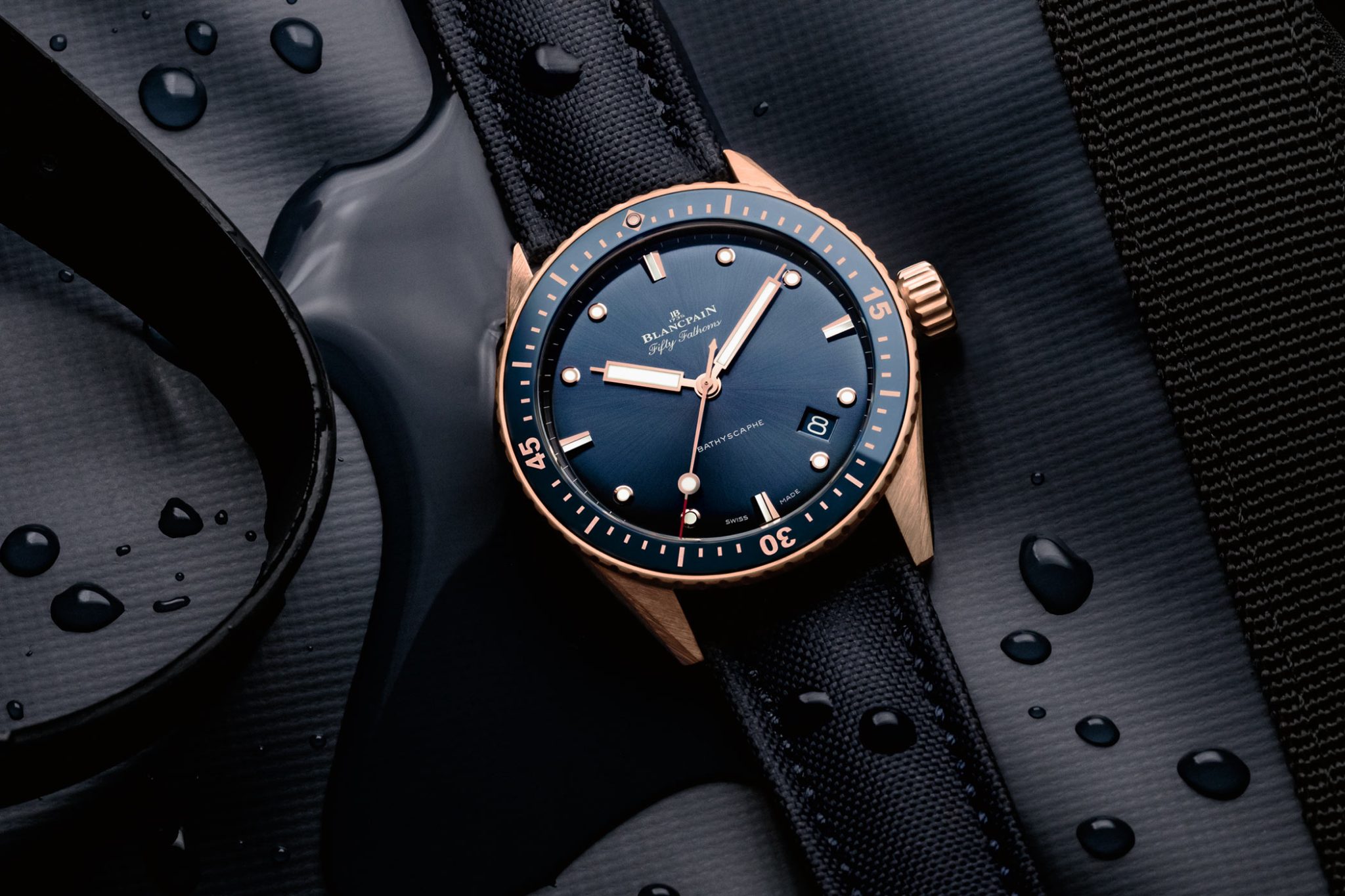
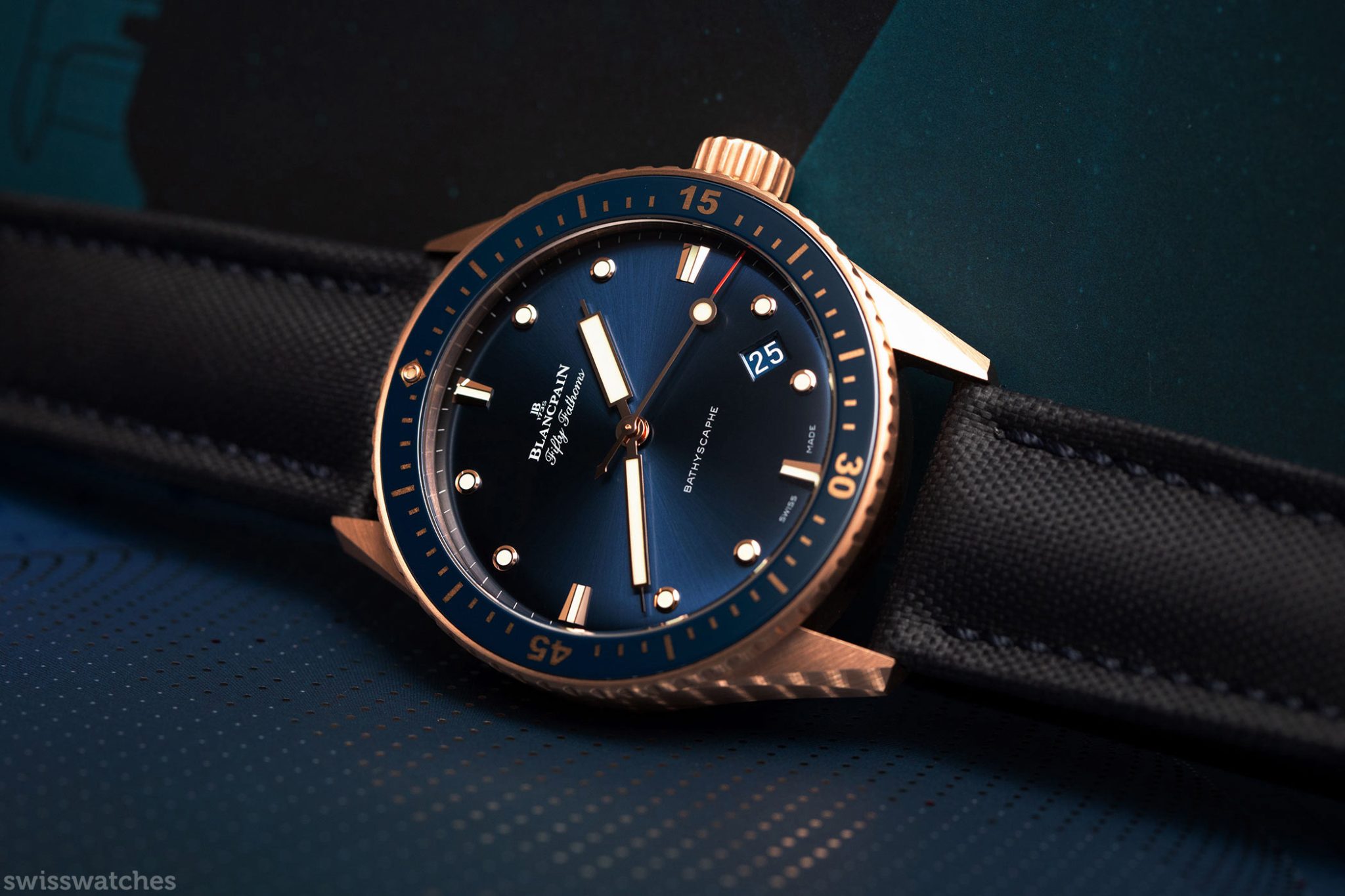
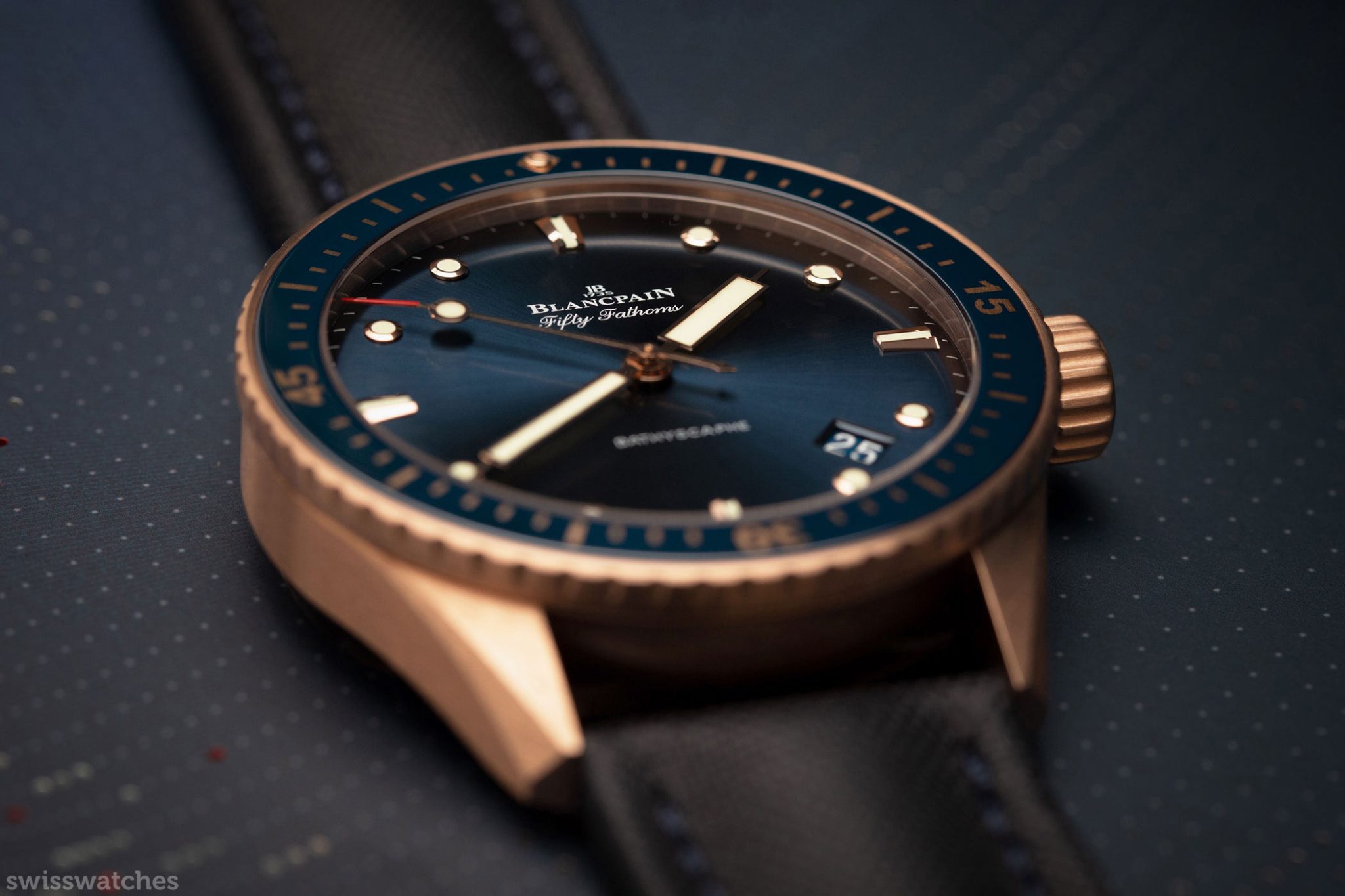
Inside, the self-winding manufacture movement 1315 ticks away. It was specially developed in 2007 for Blancpain’s sports watches and is distinguished by its five-day power reserve. This is provided with the help of three barrels connected in series.
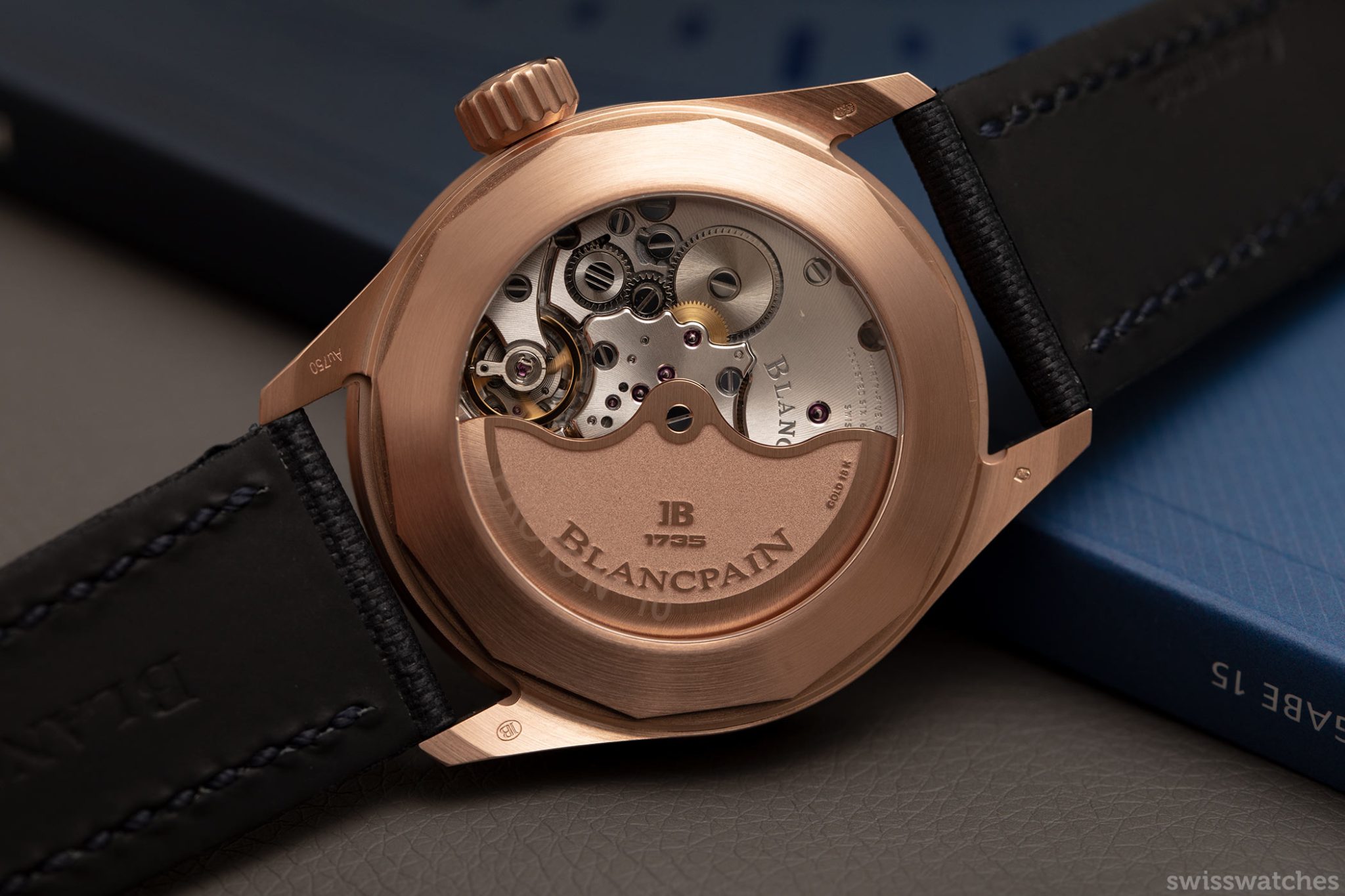
Self-winding manufacture movement 1315
While the silicon balance spring oscillates in the balance, the open sapphire crystal caseback reveals the spiralled and bevelled bridges. The beautifully finished oscillating weight in Sedna® gold with an engraved Blancpain logo is also impossible to miss. Price: 23,260 euros.
The Verdict
A guiding principle at Blancpain is: “Innovation is our tradition”. This statement presents a challenge to be progressive, without diluting a brand’s carefully developed design codes over time. In terms of Blancpain, we are talking about 285 years of company history, even if the brand’s diving watches are much younger. Blancpain makes sure that on the one hand, this history continues, but on the other hand, ensures that it is further developed, whether with new materials, functions or colours.
Blancpain’s Bathyscaphe models thus merge into a melange of robust water sports watches and fine watchmaking. The sense of aesthetics and elegance is always present in the watches, which could also explain why there are hardly any rough stainless-steel straps on the divers’ watches. I personally like this very much, because it sets them apart from the crowd – just like the many other design codes of the watches.
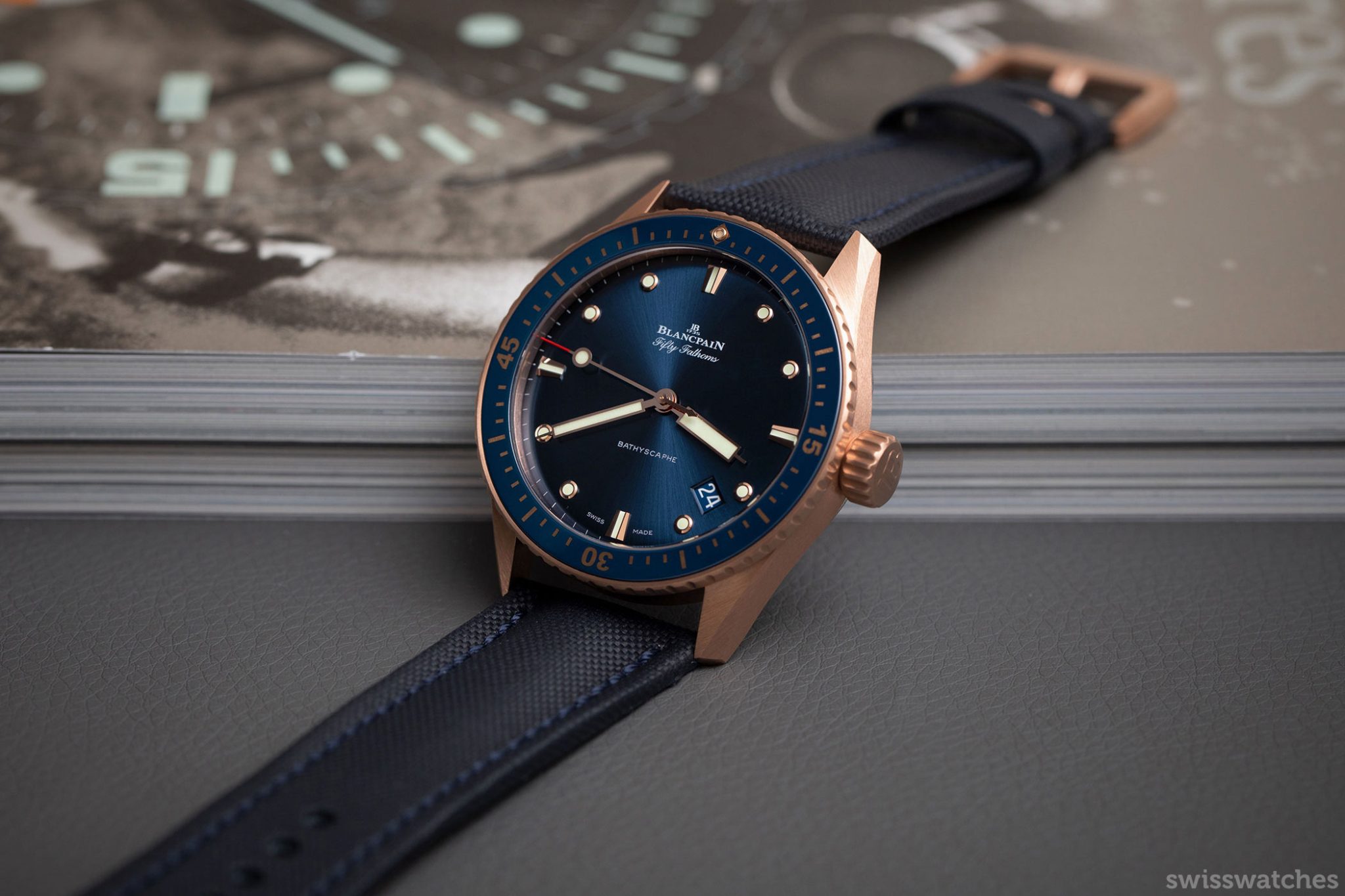
Why Blancpain’s diving watches do not necessarily enjoy the same level of recognition as their competitors may be because they are in a different league in terms of price and due to their limitation. The Bathyscaphe models, despite their fashionable appearance, serve a niche crowd – perhaps even more so than the original Blancpain diving watches. This is because the Fifty Fathoms embody all the characteristics of a genuine diver’s watch – at least more clearly than the trendy Bathyscaphe watches. But within their niche, they are a serious player with a strong history and savoir-faire.
Sources: Blancpain Lettres Du Brassus Issue Nr. 13 | Blancpain Lettres Du Brassus Issue Nr. 18 | Blancpain Lettres Du Brassus Issue Nr. 20
